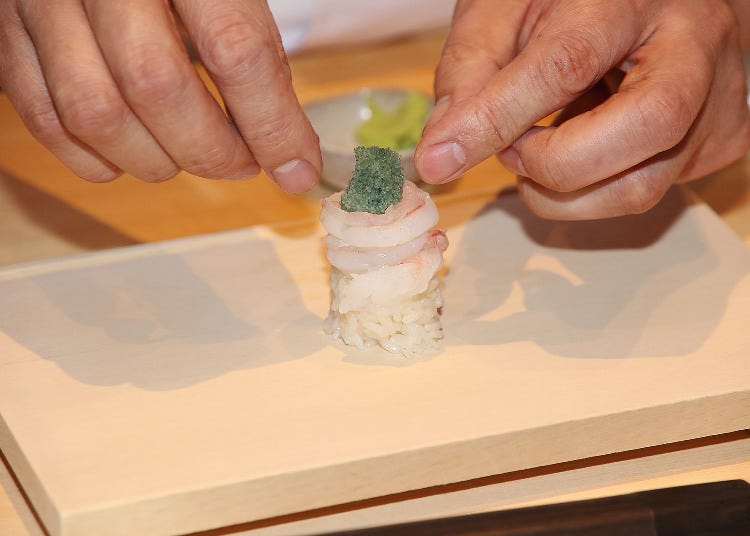
When you're looking for the best Sapporo sushi shops, head to Susukino! Here you'll find many places ranging from sushi trains to luxurious shops that serve beautiful sushi at a price you can afford.
Here are four shops recommended by the locals where you can enjoy fresh Sapporo sushi at a sushi train, one where you can sample fare popular with the regular folk at a reasonable price, and one where the sashimi and sushi is prepared before your very eyes, catering to a more mature clientele.
- Table of Contents
-
- 1. Sakana Isshin Lafiler: Savor delicious Sapporo sushi in a casual atmosphere (Shop closed)
- 2. Washoku to Sushi Nijo: Delicious Sapporo sushi dishes popular with locals, at reasonable prices
- 3. Sushi Fuji: Skillfully prepared Sapporo sushi will please the eye as well as the palate
- 4. Sushi Mikami: Fresh and Delicious Sushi
- 5. Sushi-dokoro Hyotan: Famous Star-Rated Restaurant Featuring Local Aizu Cuisine and Specially-selected Hokkaido Ingredients
- 6. Sushi Himeshara: Enjoy Sushi Culture at a Famous Two-Star Restaurant in a Residential Area
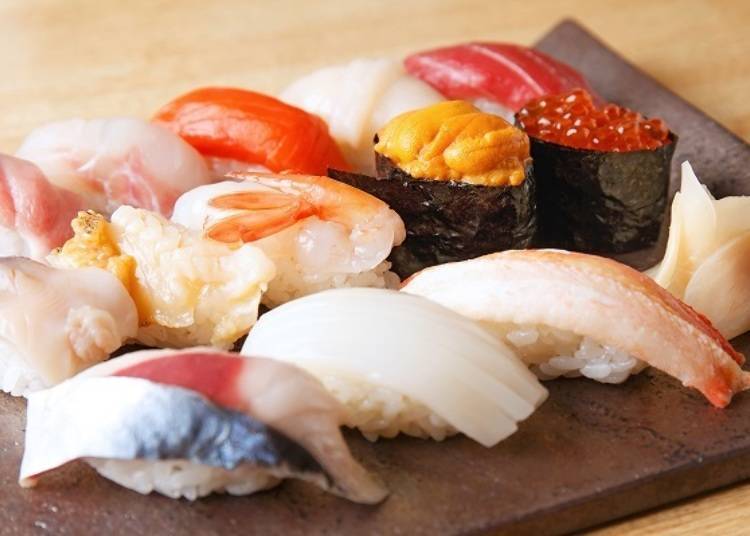
Hokkaido has an abundance of delicious seafood, Sapporo sushi is some of the best around. Regardless of their size, shops can easily obtain the freshest and most delicious seafood products. The following are the sushi restaurants we recommend.
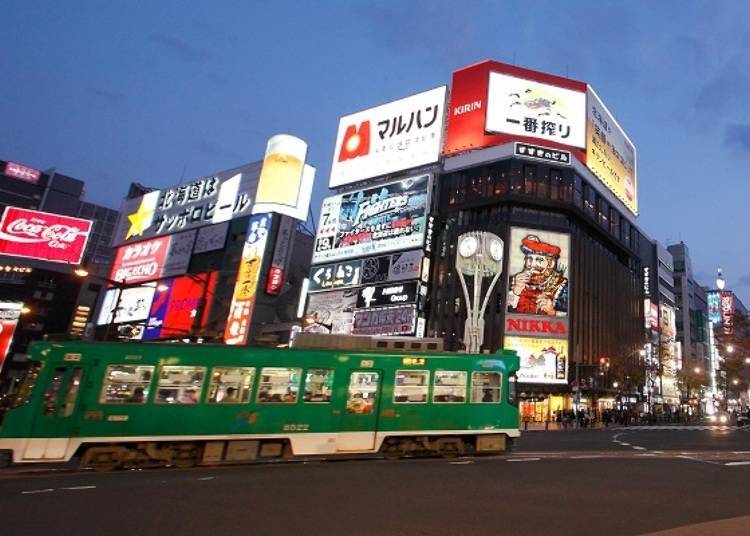
1. Sakana Isshin Lafiler: Savor delicious Sapporo sushi in a casual atmosphere (Shop closed)
First on our list of recommendations is Sakana Isshin Lafiler, a shop which is directly connected to the station.
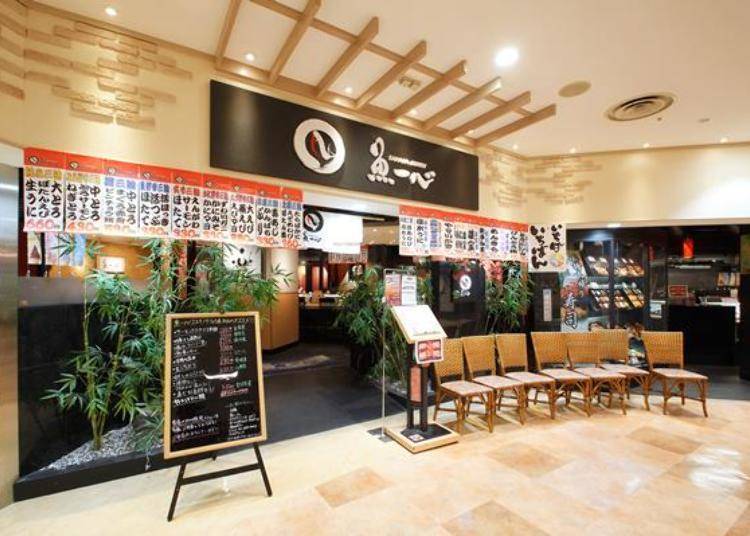
No need to worry about rain or snow as the shop is close to the ticket gate of the subway located in the second basement of the Susukino Lafiler Building. Due to its prime access, it is popular with business travelers seeking a reasonable lunch, commuters having a light bite to eat before heading home, as well as those hungry after a night of barhopping.
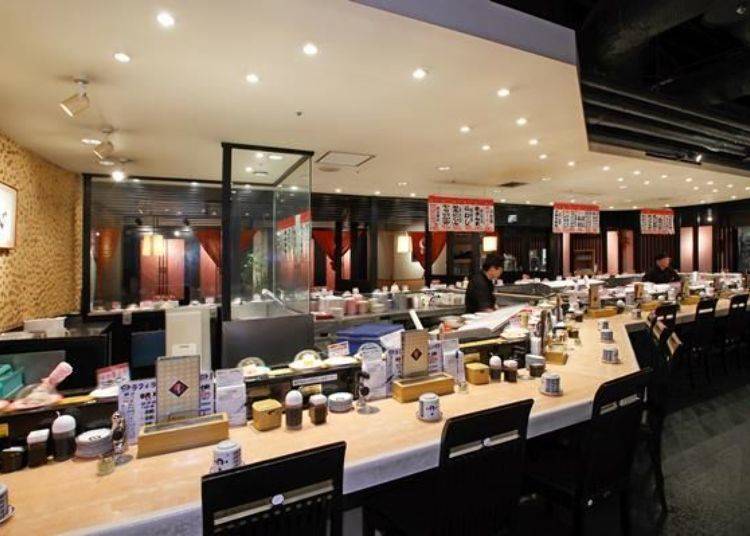
In addition to the counter, there are booths in the rear, too. All sorts of delicious types move before your eyes, but you can also request the itamae (sushi chef) to prepare any of your favorites.

On this day we asked the store manager, Hideki Takahashi, for his recommendations and enjoyed several different types of sushi. The first plate we tried was the madachi (cod milt) which is a winter dish representative of Hokkaido.
![Madachi (cod milt), the sushi topping popular with Dosanko (Hokkaido residents) [530 yen for a plate containing 2 kan (portions)]](https://rimage.gnst.jp/livejapan.com/public/article/detail/a/10/00/a1000002/img/en/a1000002_parts_5b1887151493b.jpg?20210222173132&q=80)
Madachi, or tachi as it is commonly called, refers to shirako (the milt of cod). It is odorless and has a smooth, creamy texture. The next is one of the most popular of the more expensive neta selections.
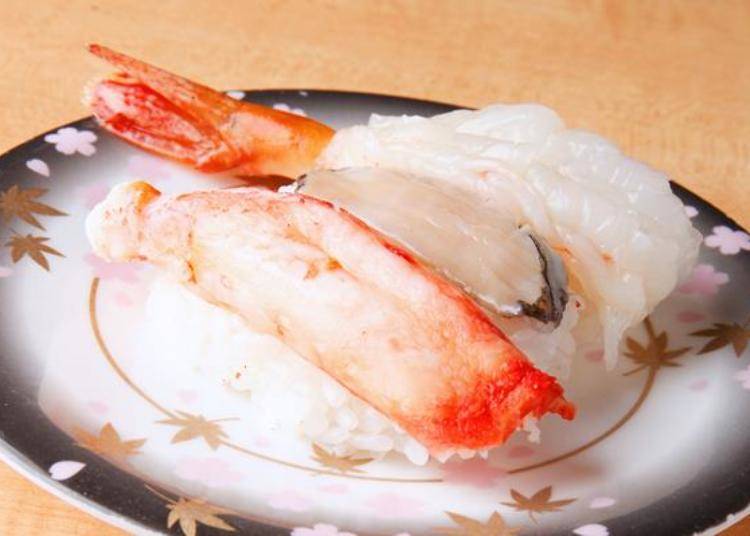
Sink your teeth into the thick crab meat, the succulent abalone, and tender shrimp to experience some of the wonderful seafood delicacies offered in this northern country.
The following set of three servings is recommended for those who like shellfish!

The flavor of each increases with each bite you take!
At Sakana Isshin part of the menu is devoted to limited discount servings, and each day new services are offered so there is always something special every time you come. This was the special on the day we visited.
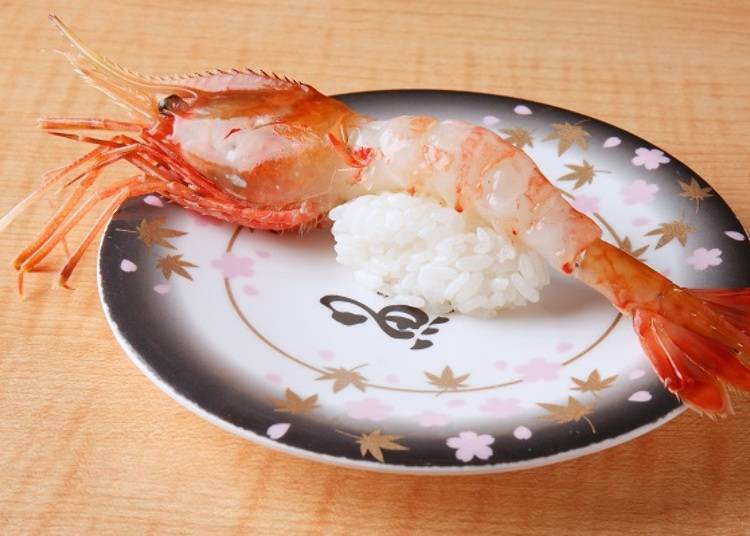

You can feel the weight of it when you lift it with your chopsticks and the size of the shrimp practically overwhelms the shari (rice) on which it sits. The flavor is so rich that it almost feels like the shrimp is dancing in your mouth!
Last of all we tried the shako (a species of mantis shrimp) that is caught around Hokkaido in spring and autumn.
![Aki shako (autumn mantis shrimp) [female], 660 yen for a plate of 2 portions. Light at first, the flavor develops steadily with each bite](https://rimage.gnst.jp/livejapan.com/public/article/detail/a/10/00/a1000002/img/en/a1000002_parts_5b18875d0e122.jpg?20210222173132&q=80)
Due to the relaxed and easy atmosphere of Sakana Isshin, the shop has many visitors throughout the day, and on Saturdays you often have to wait to be seated. A good time to visit when it is least crowded is between the hours of 3:00 and 5:00 PM on weekdays.
-
Sakanaisshin Susukino Lafiler魚一心 ススキノラフィラ店
- Address Susukino Lafiler B2F, 4, Minami4-jonishi, Chuo-ku Sapporo-shi, Hokkaido, 064-0804, Japan
- Phone Number 011-518-7177
Hours: 10:00 AM ~ 9:00 PM (last order: 8:40 PM)
Holidays: unscheduled (same as for the Susukino Lafiler)
2. Washoku to Sushi Nijo: Delicious Sapporo sushi dishes popular with locals, at reasonable prices
The next shop we want to introduce is Washoku to Sushi Nijo which is popular with local residents for its inexpensive and delicious food. It is located next to the Nijo Market which is a five to six-minute walk from the Susukino intersection that is popular with sightseers.
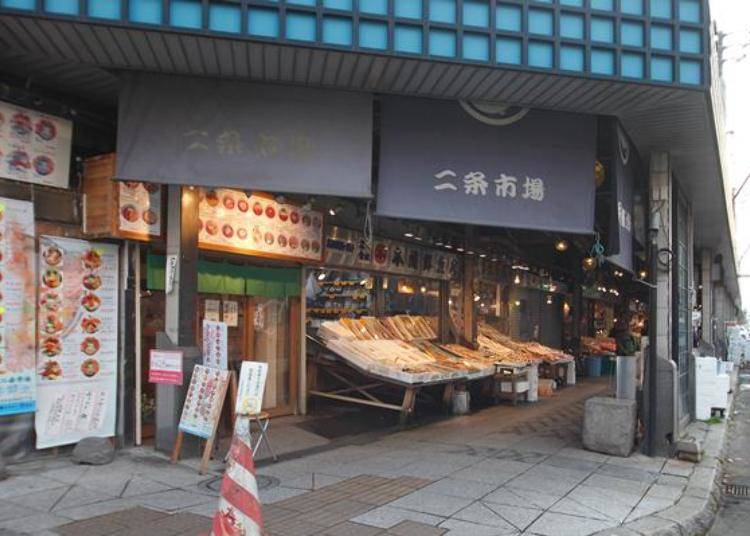
While the Nijo Market is lively with sightseers, inside the Washoku to Sushi Nijo you see mostly locals. It is popular with nearby office workers at lunchtime on weekdays and at night popular with families and guests staying at nearby hotels.
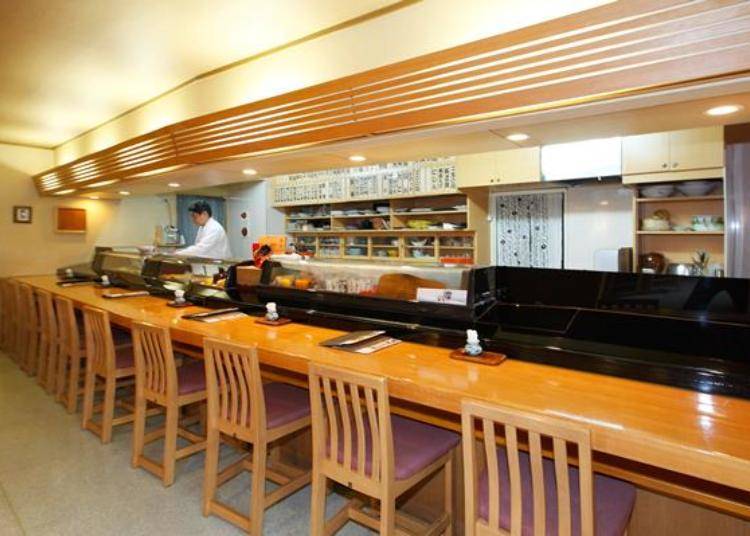
Mr. Yamamoto says that he strives to make his shop a comfortable one serving inexpensive delicious food and recommends the following three menus.
The first is naturally the nigiri (slices of seafood on balls of rice) and the most popular is this:
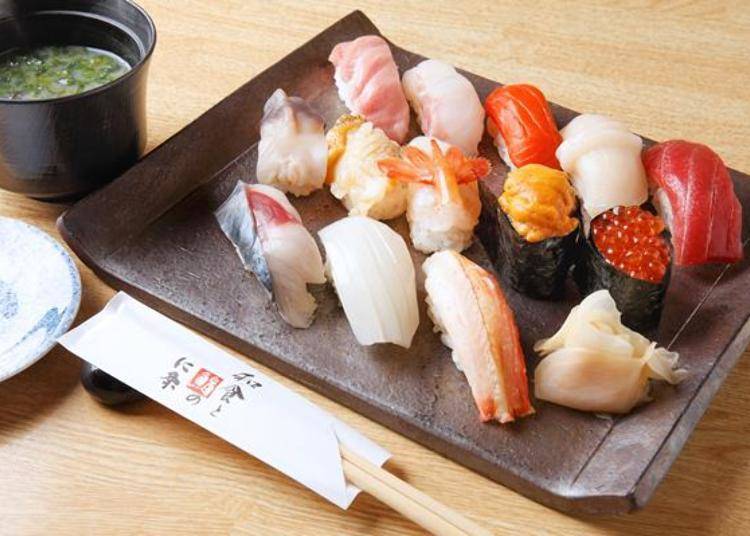
Only the finest Hokkaido sushi and seafood of the season is carefully selected and obtained from city markets. For that reason, the types of seafood offered will vary slightly according to the season, however most are offered year round.

The 13 servings may be filling, but there is one more dish you really should try and that is the ikesu neta (slices made from live seafood).
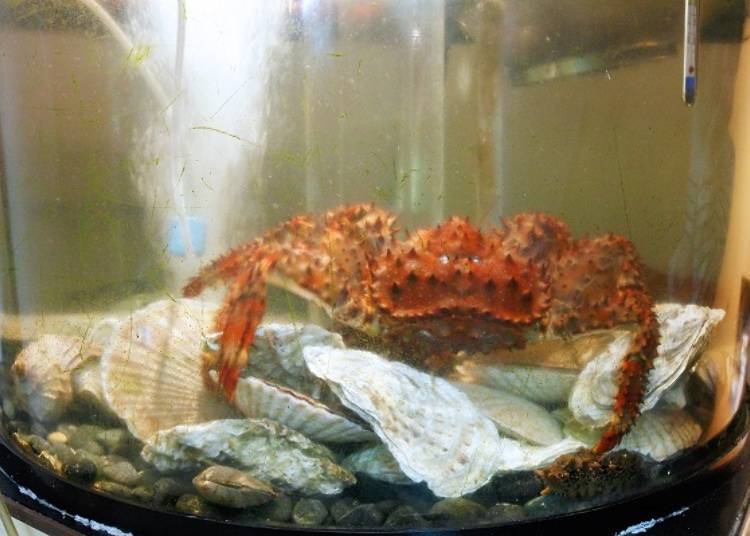
For this article we selected oysters harvested from the coasts of Hokkaido.
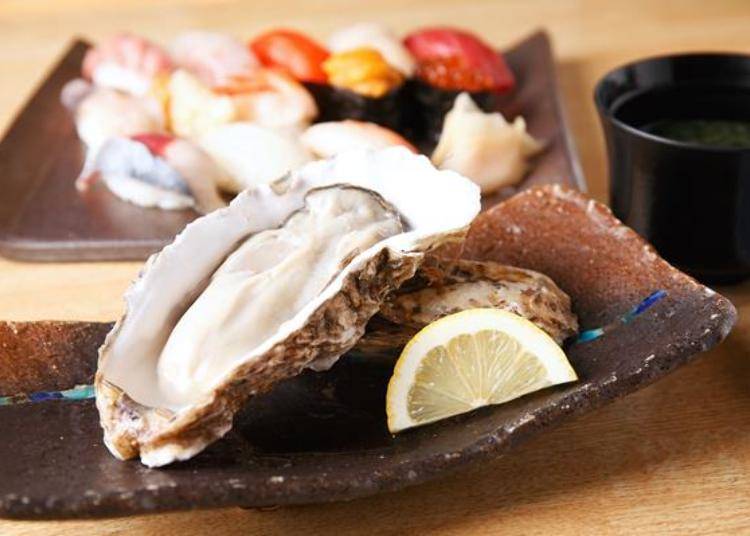
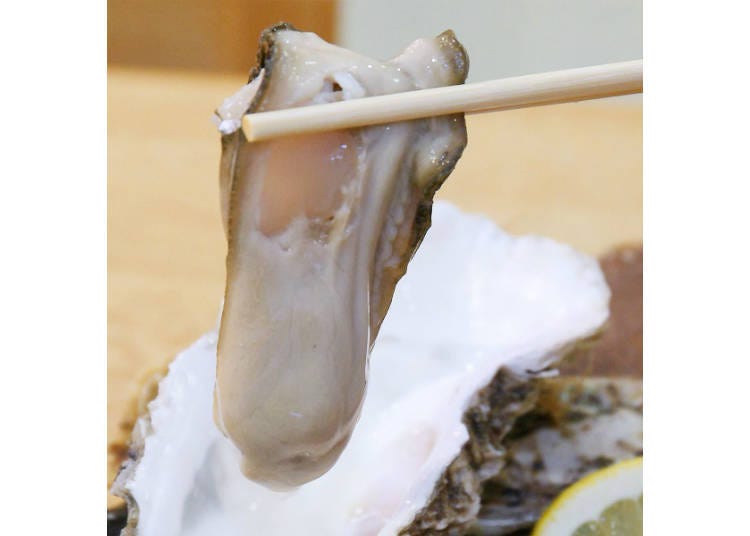
It will take more than a single delicious bite to devour these giants!
Bakudan (bomb), is the second most popular item on the menu after nigiri, and is the final one we will introduce.
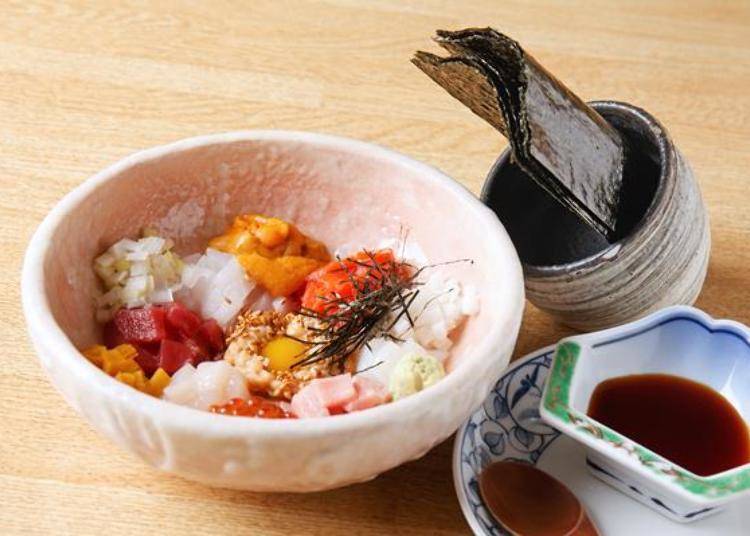
This dish includes a variety of ingredients such as sea urchin, salmon roe, red tuna, octopus, and natto (fermented beans) mixed together and topped with wasabi soy sauce. You eat it by wrapping up a spoonful in the accompanying dried seaweed.
This style is called temaki sushi which literally means hand-wrapped sushi. Instead of placing the neta on balls of rice, they are all mixed together allowing the flavors to burst forth like delicious fireworks in your mouth. After having the nigiri we recommend sharing an order of this among two or three people.
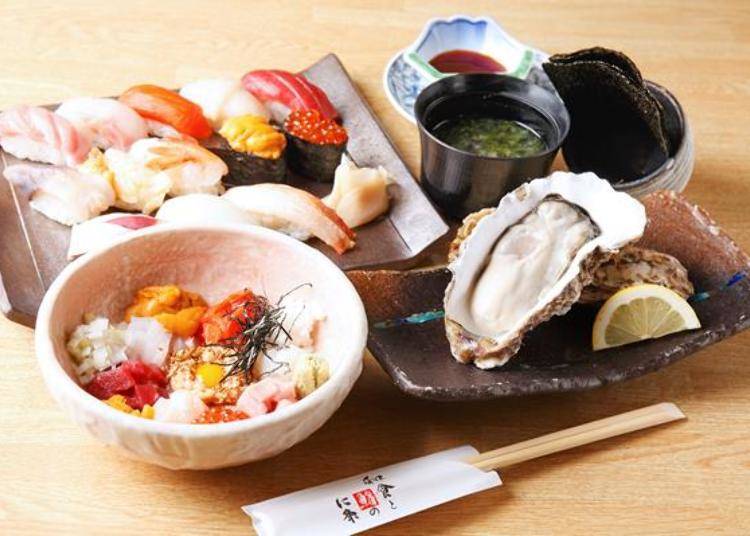
In addition to sushi and raw seafood dishes, grilled fish, tempura, fried and stewed dishes are also offered as well as meat and vegetables, so there is a broad selection to choose from on the menu.
Covid-19 Countermeasures
Sanitizer installed / Disinfected after each guest leaves / Ventilation measures in place / Coin trays used / Plastic partitions installed / Staff wear masks, gargle, wash hands regularly, and monitor body temperature / Limited capacity / Increased space between seats / Limited admissions, reservation system employed / Entry declined to anyone who is feeling unwell / Masks required / temperature check enforced
-
Washoku to Sushi Nijo和食と鮨 に条
- Address Puresanto 1F, 2-6-1, Minami3-johigashi, Chuo-ku Sapporo-shi, Hokkaido, 060-0053, Japan
- Phone Number 011-219-1346
Hours: 11:00 AM ~ 3:00 PM (last order: 2:30 PM); 5:00 PM ~ 10:00 PM (last order: 9:30 PM)
Closed: Wednesdays
3. Sushi Fuji: Skillfully prepared Sapporo sushi will please the eye as well as the palate
Next we introduce Sushi Fuji, a shop well-known among discriminating diners. It is located a short two to three-minute walk from the Susukino intersection.
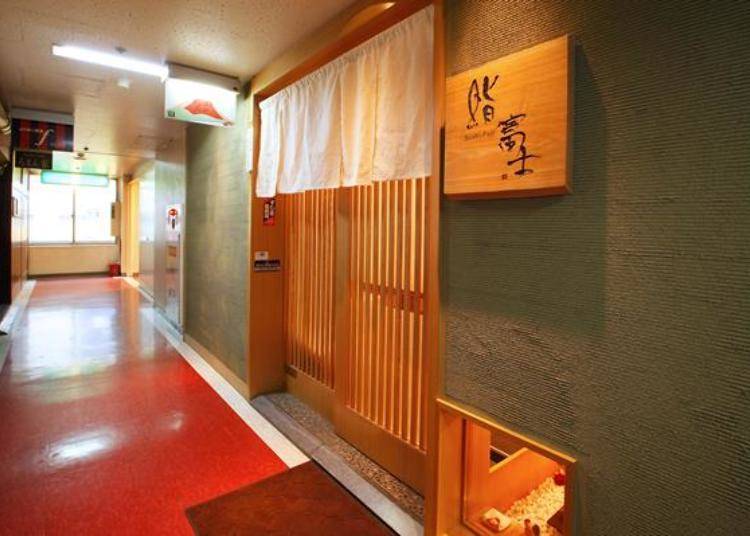

This cozy establishment is owned and operated by Mr. Shinya Kudo, the chef, and his wife, Kumiko.
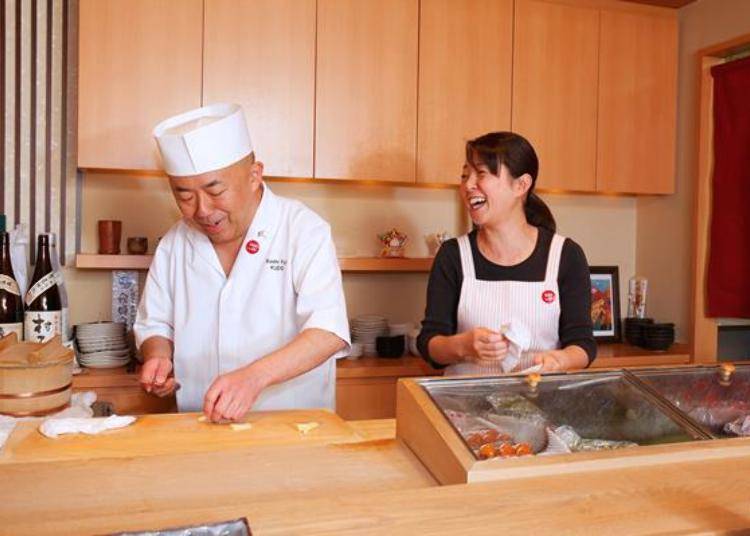
After beginning his career and working 21 years at Sushi Zen, one of Sapporo’s most famous sushi restaurants, he next spent six years polishing his skills at the famous Sushi Dokoro Jun in the Ginza district of Tokyo before returning to Sapporo, his birthplace, and opening Sushi Fuji in 2008.
Here it is possible to enjoy Edomae sushi, the style that originated in Edo, the old name of Tokyo. He prepares each serving using the freshest and finest seafood ingredients to be found in Hokkaido.
Try an unforgettable course prepared by a master itamae using the finest ingredients!
You may be anxious sitting in this exclusive restaurant that serves the finest of ingredients about what to order and what it will cost as you sit facing the master from across the counter.
But you need not worry! While you of course can order a la carte, for first-time visitors we recommend ordering a course from the menu, something many patrons prefer to do.
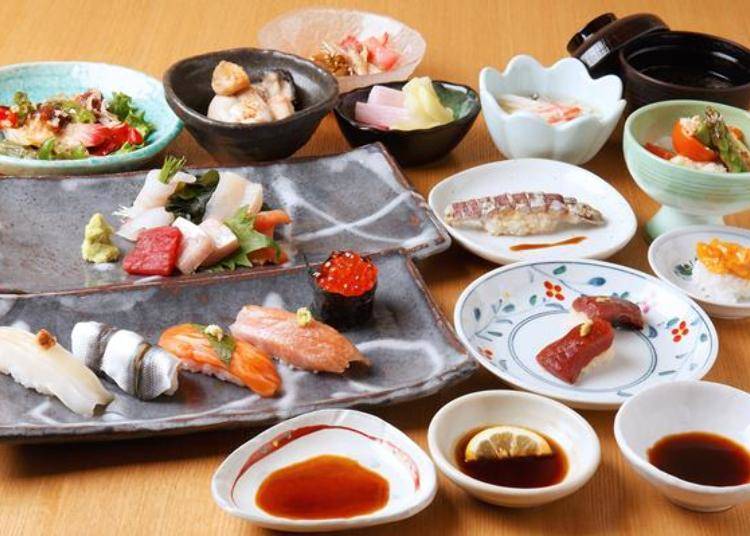
This menu includes otoshi (appetizer), odzukuri (sliced raw fish), two kobachi (small dishes), 8 kan of sushi, owan (bowl of soup), and konomono (pickles), served in that order (sometimes the contents and presentation may differ depending on availability of seafood on hand).
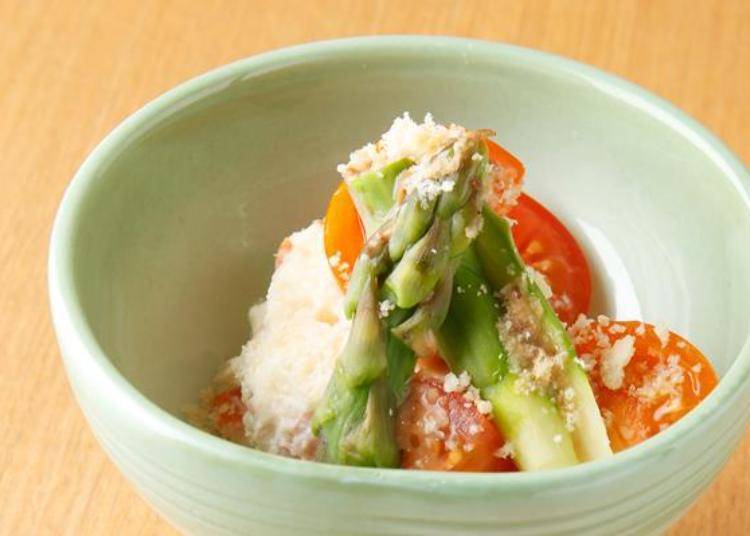
After the otoshi came a dish especially recommended in addition to the set menu!
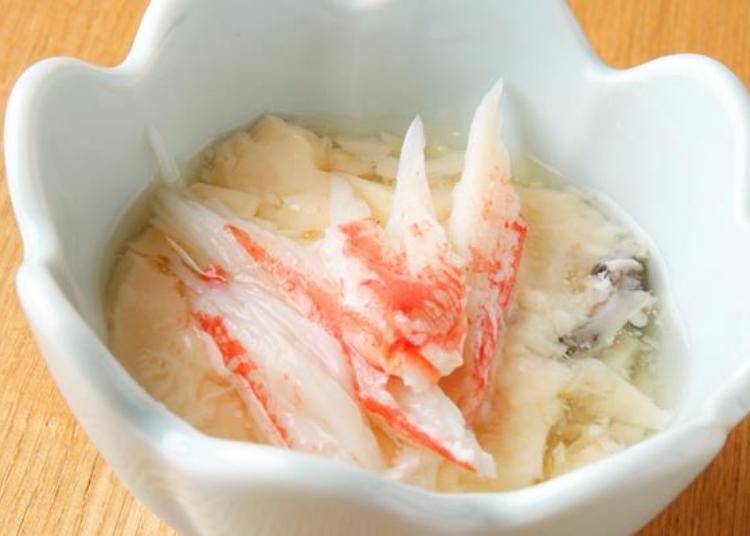
Next comes the odukuri. This usually is made with something seasonal. This time everything but the akagai (ark shell clam) was from Hokkaido.
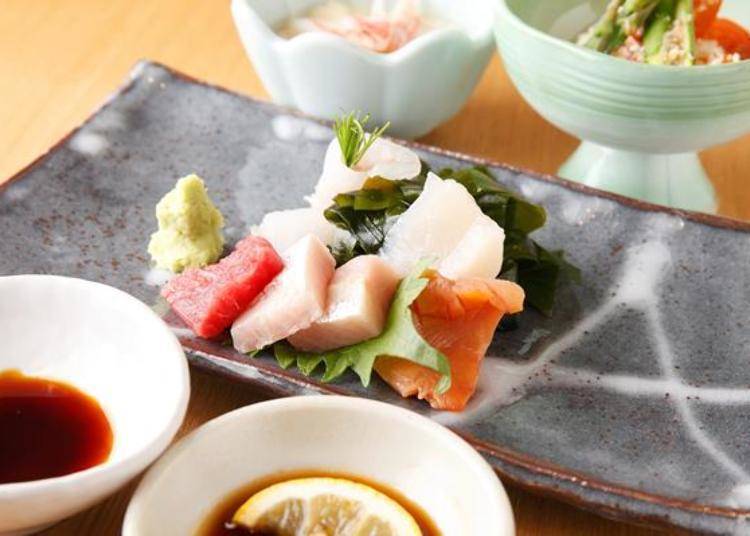
The master explains that the dishes are served in an order by which the lighter dishes are followed by those a bit heavier.
First we had Otaru flounder wrapped in green onion sprouts. After that came soi (fox jacopever) from Shakotan; akagai (ark shell clam) from Yuriage, Miyagi Prefecture; hotate (scallops) from Sarufutsu; maguro (tuna) from Toi in the Tsugaru Straits; burinose (the back slice of amberjack) from Yoichi; and after that a stomach cut of amberjack. I alternated dipping the slices in the wasabijoyu (wasabi-flavored soy sauce) and ponzu sauce made with freshly harvested Hokkaido seaweed.
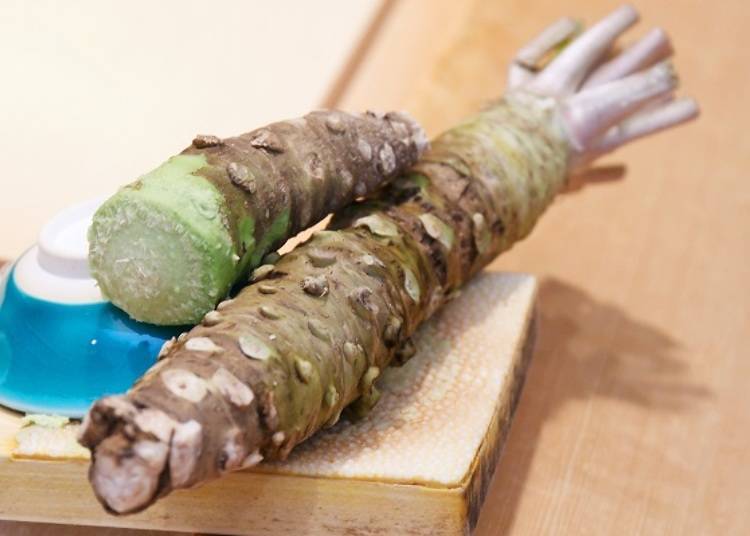
If the dishes are eaten in the order prescribed above, the flavor of each dish enhances that which follows; the odzukuri almost being an entire course in itself!
This was followed by two “small bowl” grilled dishes.
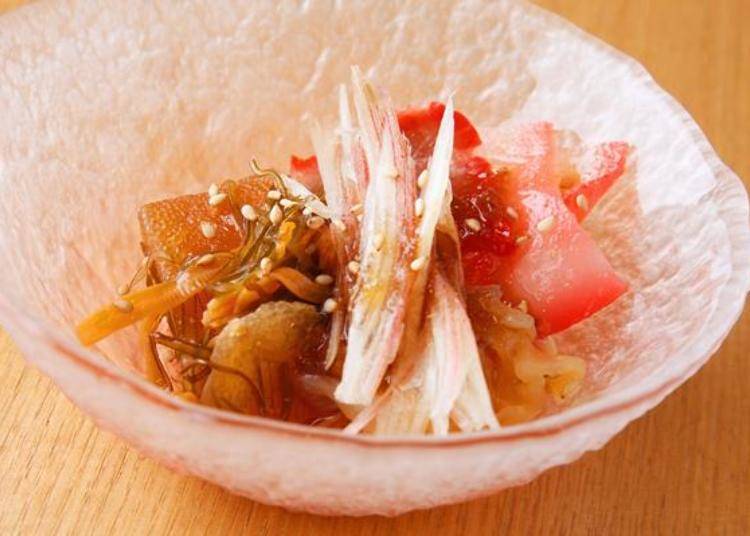
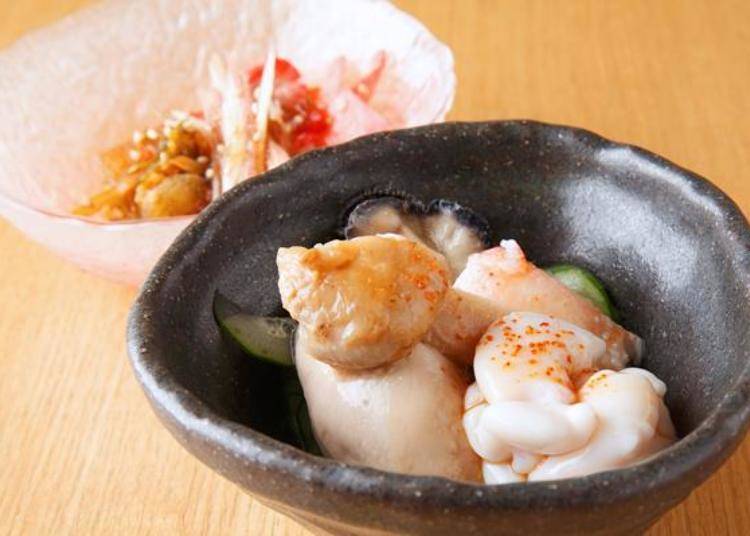
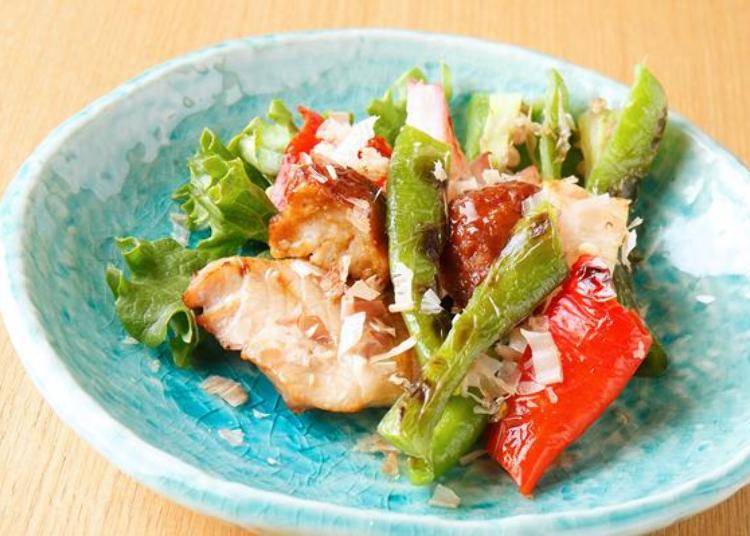
This tantalizing dish is followed by the main nigiri course, each kan to be enjoyed in the order presented.
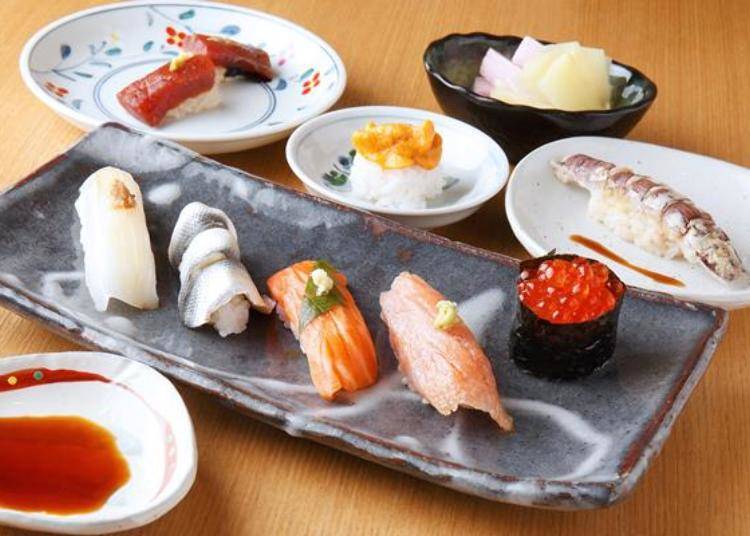
The master and his wife work in perfect harmony as though as one. As the master begins preparing the nigiri, at the perfect moment she sets out an oshibori (damp hand towel) for fingers and a soup bowl containing seaweed.
The soup is comprised of seven parts Shinshu miso and three parts red miso from Aichi Prefecture – the perfect blend to complement the flavor of the sushi. Pickles are also served for refreshing the palate.
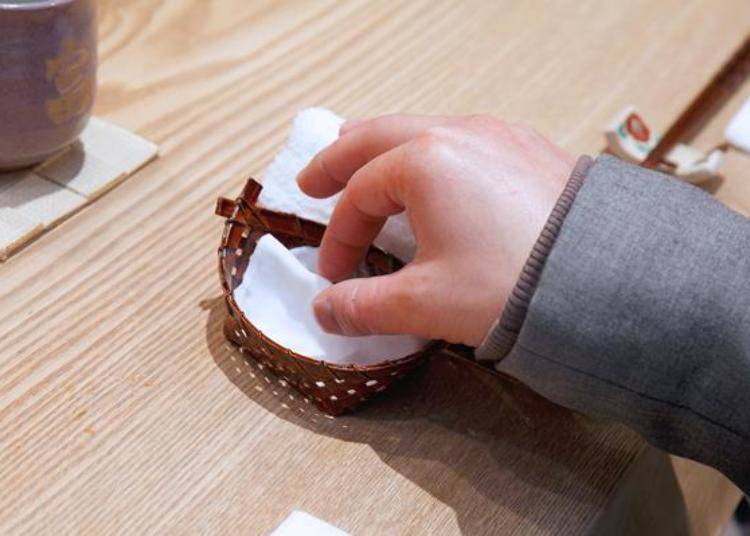
Now let’s try the nigiri!
First: surume ika (squid)
Served with mountain wasabi, not regular wasabi, and bonito, slathered with nikiri shoyu (soy sauce containing water, sake, mirin (sweet sake), and soup broth).
Second: kohada (medium-sized gizzard shad)
A smaller portion of shari (rice) topped with a large slice of fish! It has already been slathered with nikiri shoyu so eat it as it is!
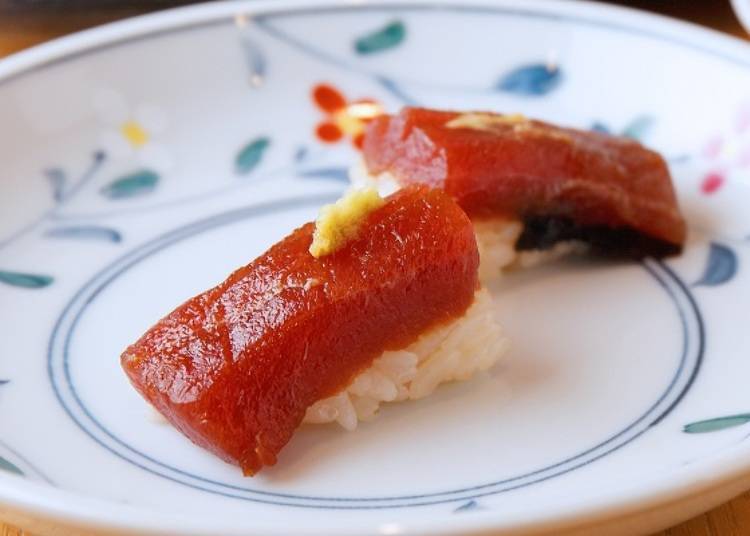
Third: maguro no tsuke (pickled tuna)
Wasabi is put on top of the neta in the first one, so the next one has seaweed between the shari and neta, then slathered with nikiri shoyu after which a dab of wagarashi (Japanese mustard) is applied. Wagarashi is spicy yet mellow!
The shari for the pickled tuna is different from regular shari; it uses red vinegar instead of normal vinegar which tightens the flavor.
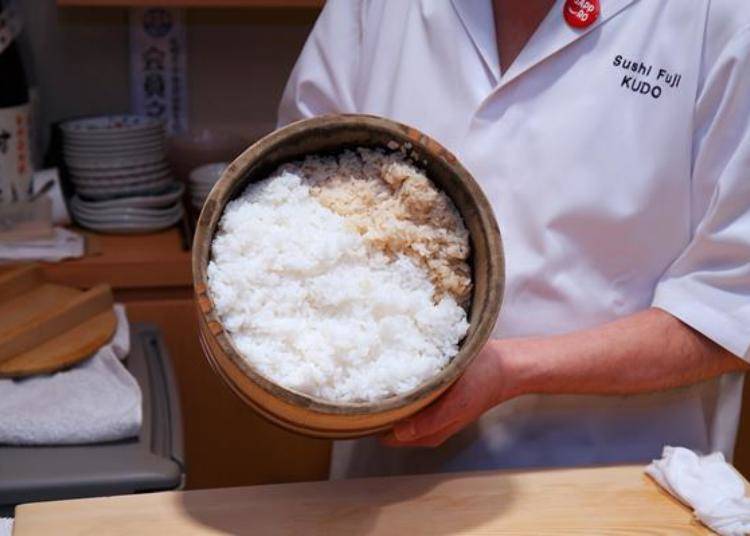
Fourth: Hidaka-san sake no ginsei (wild chum salmon caught near Hidaka)
Ginsei is the name given to wild chum salmon caught only in the Hidaka region of Hokkaido. Also known as ginkezake, it is said to be the “king” due to its beautiful silver shape, rich texture, and taste. For this the slightly sharper mountain wasabi grown in Hokkaido is used instead of regular wasabi. The leaf of the beefsteak plant gives added accent.
Fifth: Toi-san maguro no otoro (fatty tuna from Toi)
Toi is part of Hakodate City and is on the other side of the Tsugaru Straits that separates it from Oma Town, Aomori Prefecture which is famous for its tuna. The fatty tuna is made from the head of tuna caught in that part of the sea. Abundant in fat content, the meat melts in your mouth it is so soft.
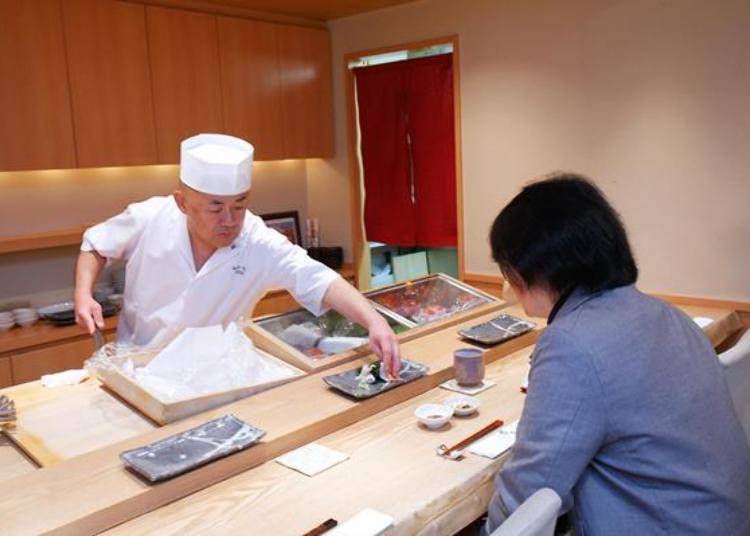
Sixth: Hamanaka-san bafun uni (horse-dung sea urchin harvested at Hamanaka)
“Would you prefer rock salt or nikiri shoyu?”
After inquiring as to your preference, the master then makes the nigiri putting the condiment you requested on top of it. I ordered the rock salt as I think it gives it a uniquely different taste.
Each serving is about a single mouthful, but the flavor is so rich that it gives the sensation of having eaten dozens of them. Truly a sumptuous dish!

Seventh: Jikasei ikura (homemade salmon roe)
As with the sea urchin, each serving is bite-sized on a round gunkan (shari wrapped with seaweed). Many of the patrons enjoy sake with their sushi, and it is for that reason the size of the servings are kept modest. The sensation of the roe bursting in your mouth and then melting away is exquisite!
Eighth: Otaru-san shako (mantis shrimp from Otaru)
Mantis shrimp is caught in spring and autumn and then boiled. After servings of rich and fatty neta, the mantis shrimp is the perfect follow-up for concluding the feast.
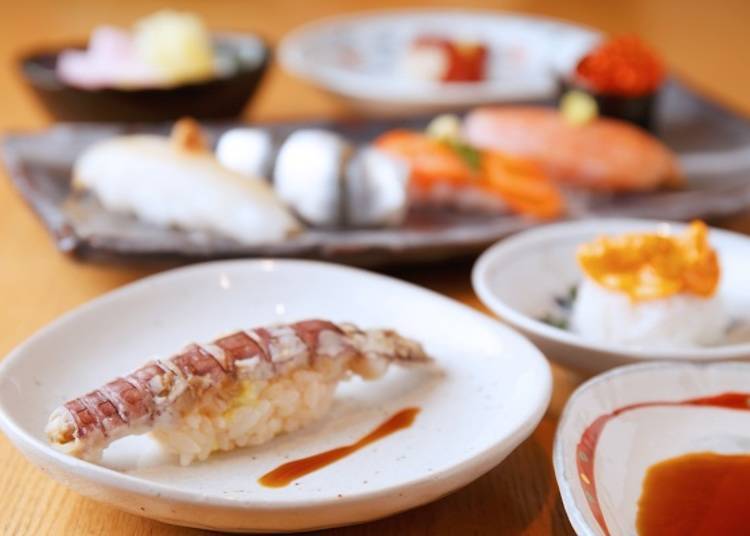
And that is the complete course!
Watching the skilled technique of a master sushi chef and enjoying the ambiance of warm conversation with the master and his wife, this is truly an unforgettably luxurious experience, one that can be enjoyed with eyes and ears, as well as the mouth. The chef is a master at striking the perfect balance with the finest ingredients available.
Covid-19 Countermeasures
Sanitizer installed / Disinfected after each guest leaves / Ventilation measures in place / Plastic partitions installed / Staff wear masks, gargle, wash hands regularly, and monitor body temperature / Limited capacity / increased space between seats /Limited admissions, reservation system employed / Entry declined to anyone who is feeling unwell / Masks required / temperature check enforced
-
Sushi Fuji鮨 富士
- Address Sanjo Utsukusimatsu Bld. 3F, 5-14, Minami3-jonishi, Chuo-ku Sapporo-shi, Hokkaido, 060-0063, Japan
- Phone Number 011-219-7880
Hours: 5:30 PM ~ 11:00 PM (no entry after 10:30PM) *Guests with reservations are given priority
Holidays: unscheduled
4. Sushi Mikami: Fresh and Delicious Sushi
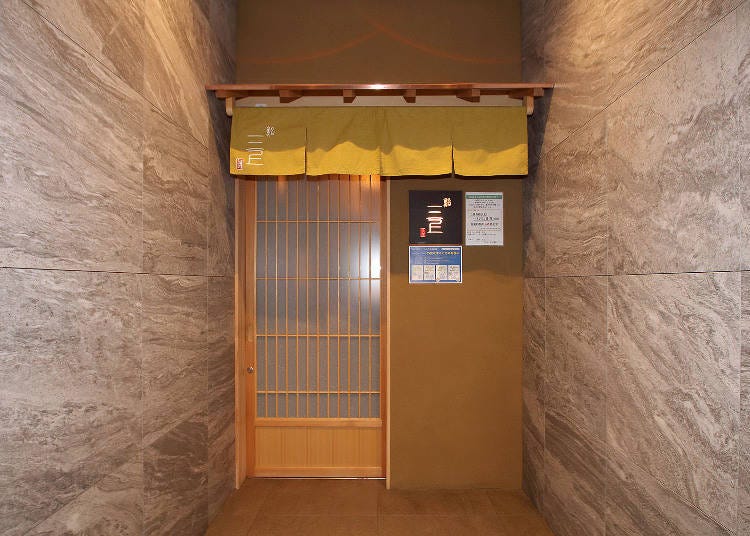
Sushi Mikami is a Sapporo sushi shop located just a few minutes from the Susukino intersection. This Edomae sushi restaurant prides itself in its rice, vinegar, seaweed, and of course, fish.
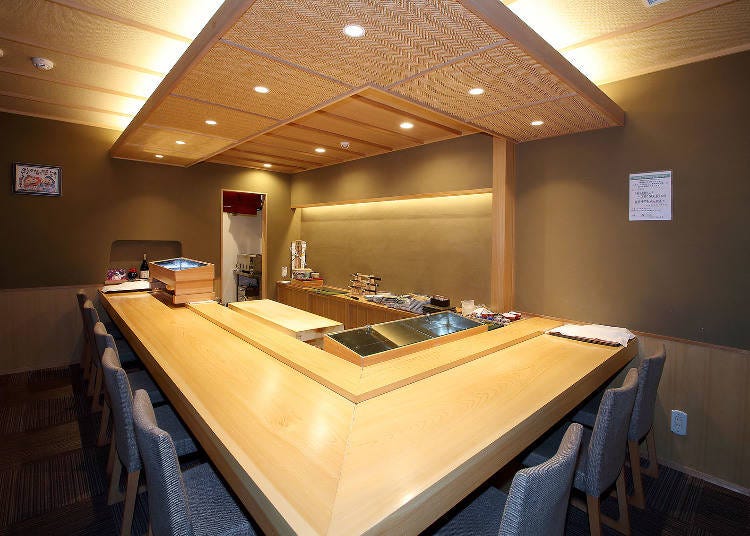
Sushi chef Mikami recommends sitting at the counter, where you can watch the food being freshly prepared by hand.
By taking the time to hand-roll the sushi carefully and trapping air between the grains of rice, the texture of the sushi changes.
The private room is right next to the counter seats, and they waste no time bringing your food to you. The chef's craftsmanship is clearly noticeable!

Sushi Mikami's standard menu item is the Taisho Omakase Course (starting at 13,000 yen, including tax). First, you are served 6 appetizers, including sashimi, and grilled and steamed foods. Following that are about 10 individual pieces of rolled sushi.
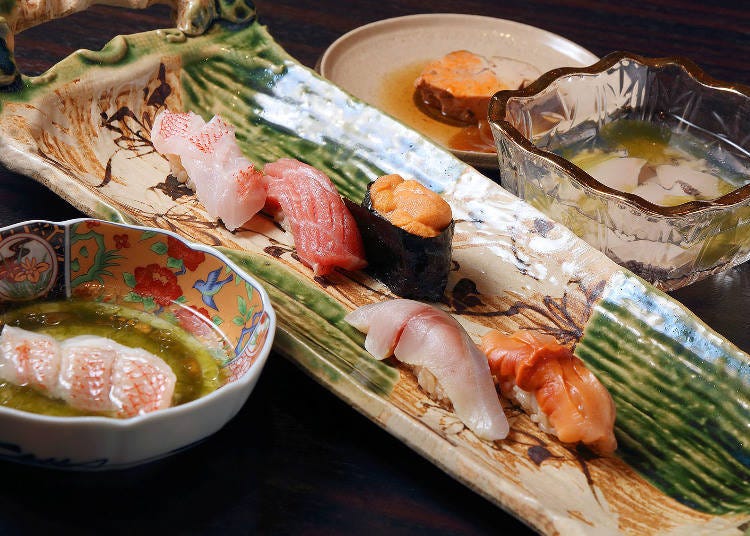
Mikami offers a mix of recommended standard items as well as daily specials made with seasonal ingredients, resulting in a menu whose contents and availability vary day by day. What surprises await your visit?
Mikami takes the time and effort to perfect the flavors of each ingredient.
Here are some of Sushi Mikami's standard dishes.
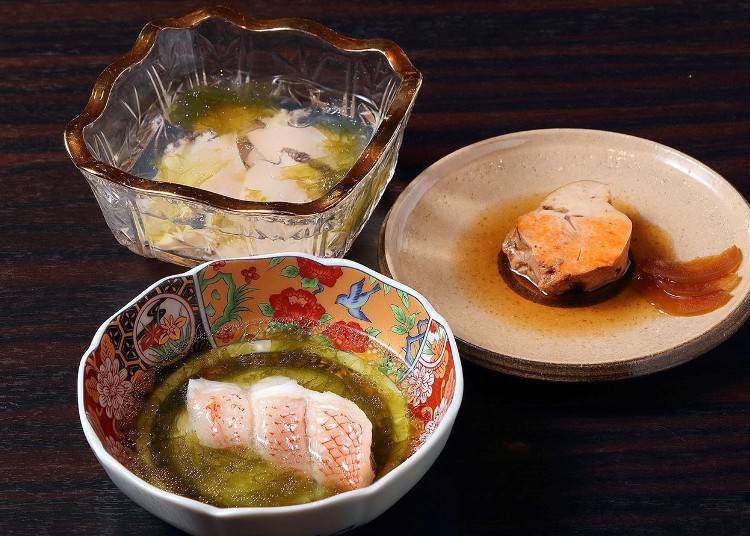
First, we have the sashimi. Their sashimi is more than a simple cut-and-served slice of raw fish. It is Mikami sashimi, prepared to Mikami perfection.
Their standard sashimi is mizugai, or abalone. When soaked in salt water, not only is the taste of the raw abalone enhanced, but the salt water itself takes on the flavor for a delicious abalone broth.
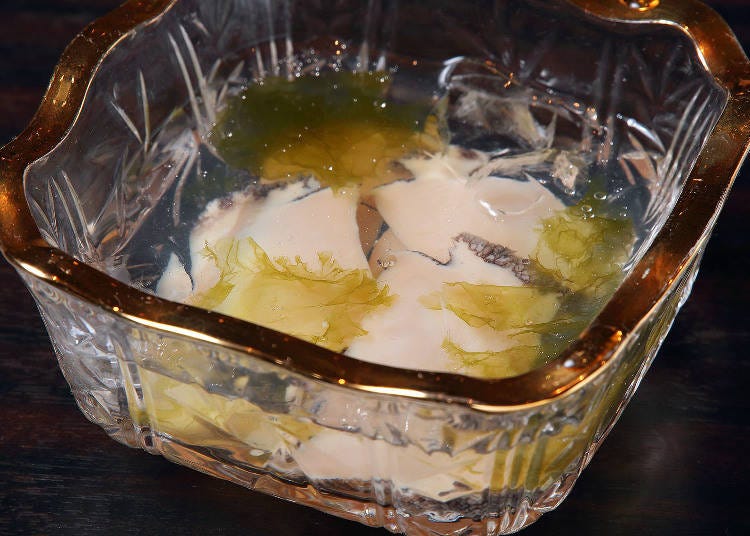
Next up is ankimo, steamed anglerfish liver from Yoichi, Hokkaido. This fatty fish is a classic winter staple, though they can sometimes be found in the middle of summer. Though anglerfish are landed only rarely in the summertime, it is said that summer catches are also fatty and delicious.
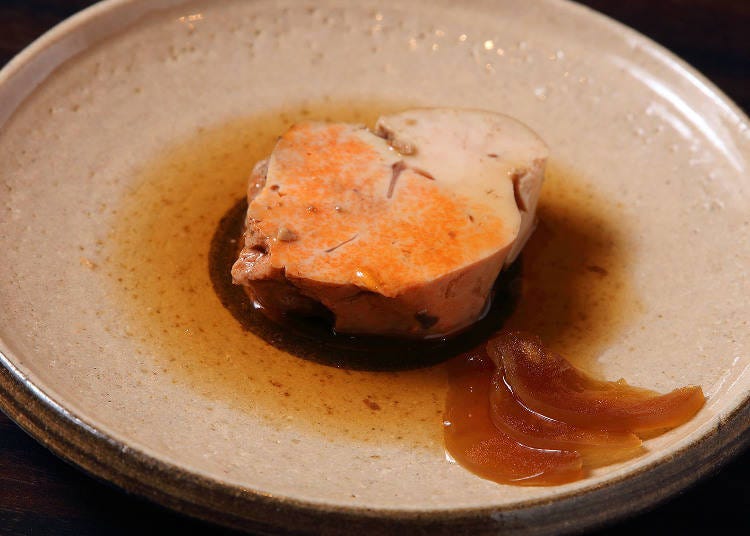
Salted kinki (rockfish) is another delicious and fatty winter dish. Their kinki comes from Rausu, Hokkaido, and is boiled in salt and combined with a seaweed called sea lettuce. This dish is offered from November to the end of February.
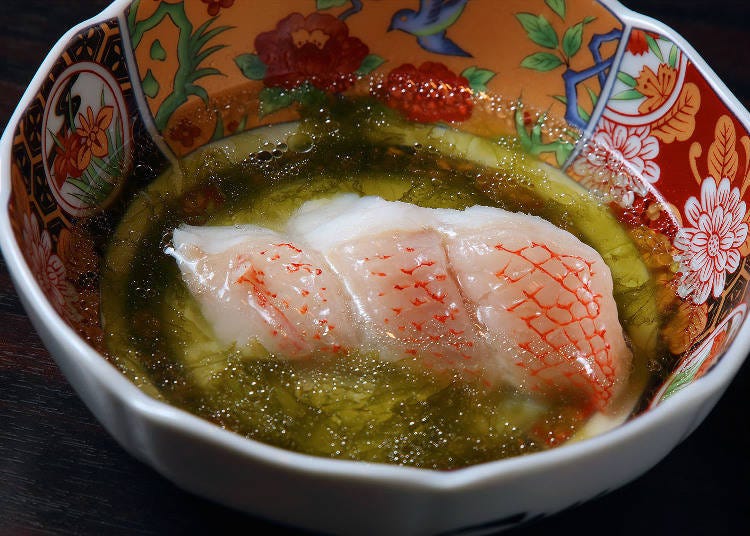
Now let's take a look at some of the main sushi rolls.
Shime Saba (cured mackerel) is an autumn and winter staple, when mackerel catches tend to be the fattiest. Mackerel, kohada, and tuna are said to become even more flavorful when left to sit for a few days.
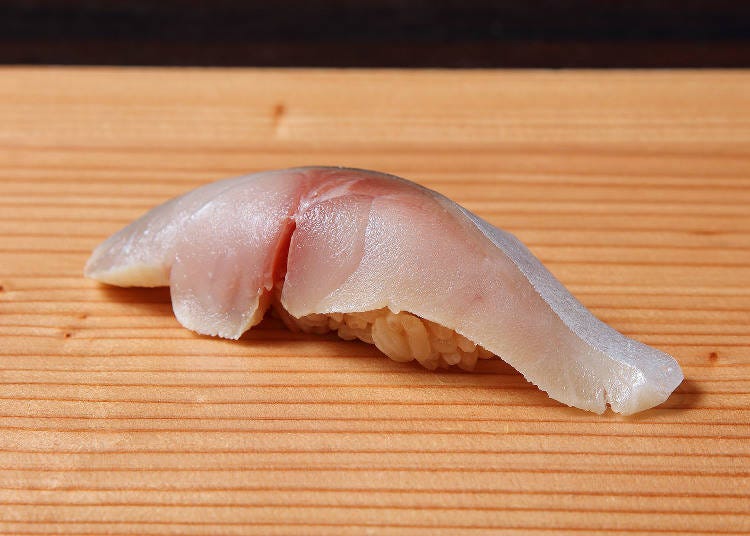
Uni (sea urchin) Gunkanmaki is a standard sushi item that combines the taste of the finest seaweed, fish, and rice. It is made with the best sea urchin and sushi rice in Hokkaido, and wrapped in a high-class seaweed from the Ariake Sea in Kyushu called Kontobinori.
The custom-made Nori Blend is rich in the delicious flavor of seaweed! It costs three times as much as ordinary seaweed.
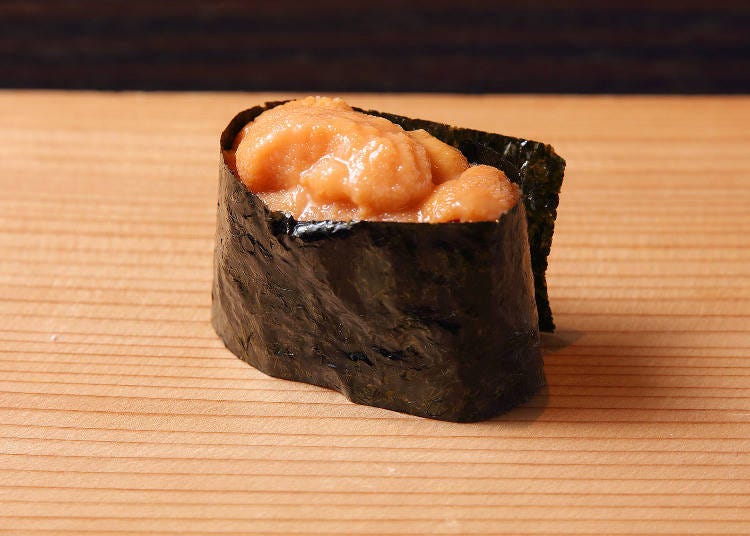
The shop is even more particular about their sushi rice!
According to Mr. Mikami, "All sushi restaurants should use high-quality ingredients. But even if everything else is good, without high-quality rice, the sushi will be ruined."
Their sushi rice is a blend of Hitomebore and Akitakomachi rice from Tome, Miyagi Prefecture. They don't use new rice. Their shop specially stocks and uses only rice that has been aged for one year, which is said to go well with the vinegar.
They use red vinegar for this rice, also aged 3 years. Aged vinegar has a stronger sweetness, which brings out the sweetness of the rice, resulting in a delicious sushi rice made without sugar.
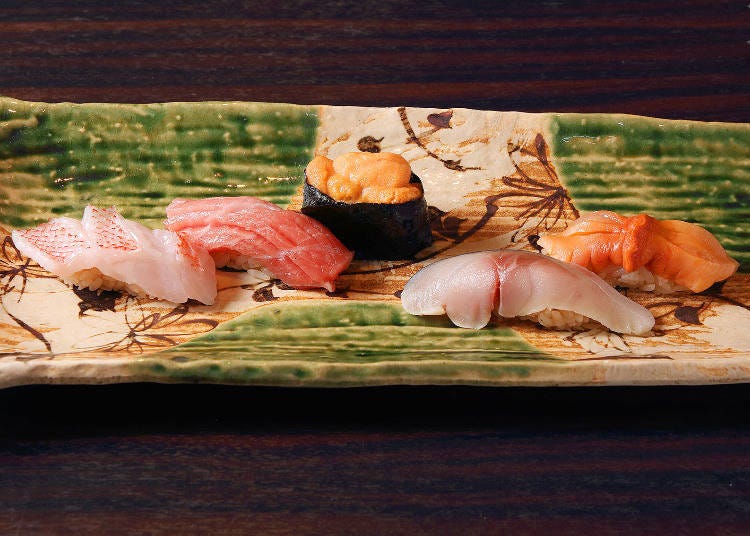
There are many other great specially-made dishes, including Steamed Abalone (which is steamed for 6 hours), and Boiled Octopus.
Although it takes some time to prepare the dishes, Sushi Mikami keeps their seasonings simple in order to not mask the flavor of the ingredients. Many items are only seasoned with a small amount of salt or soy sauce.
This place is popular not only with Japanese customers, but with foreigners as well. Some regular customers are tourists who stop by every year when visiting Hokkaido. Try ordering the Chef's Recommendation! Through simple communication in English, you can enjoy the finest Edomae sushi made with some of the finest ingredients!
Covid-19 Countermeasures
Sanitizer installed / Disinfected after each guest leaves / Ventilation measures in place / Coin trays used / Staff wear masks, gargle, wash hands regularly, and monitor body temperature / Limited capacity / increased space between seats / Limited admissions, reservation system employed / Entry declined to anyone who is feeling unwell
-
sushimikami鮨 三上
- Address Dai21katsurawa Bld.1F, 4-5-10, Minami6-jonishi, Sapporo Shi Chuo Ku, Hokkaido
5. Sushi-dokoro Hyotan: Famous Star-Rated Restaurant Featuring Local Aizu Cuisine and Specially-selected Hokkaido Ingredients
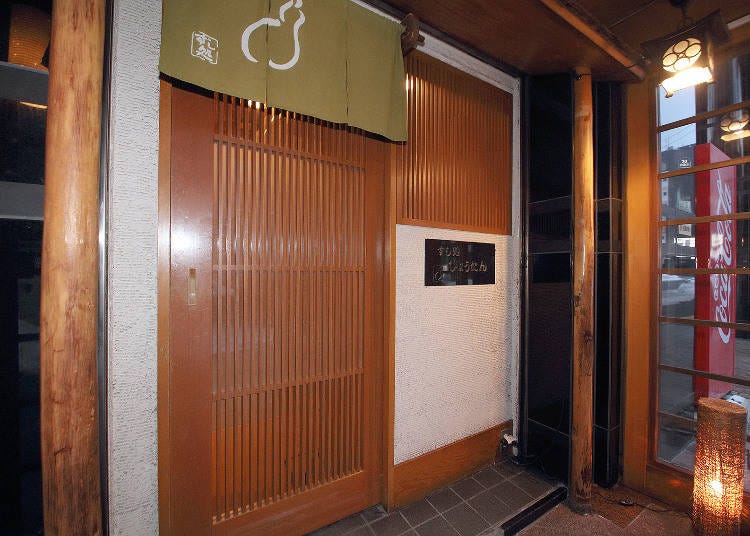
The next restaurant we will introduce is Sushi-dokoro Hyotan, a long-established sushi restaurant in Susukino with a 40-year history. This well-known shop has even won a 2-star rating in the Michelin Guide Hokkaido 2012 Special Edition. It is about 5 minutes on foot from the Susukino Intersection.
Since there are no curtains out front, you might not realize that it is a sushi restaurant at first. It appears more like a secret hideaway - a daring style choice!
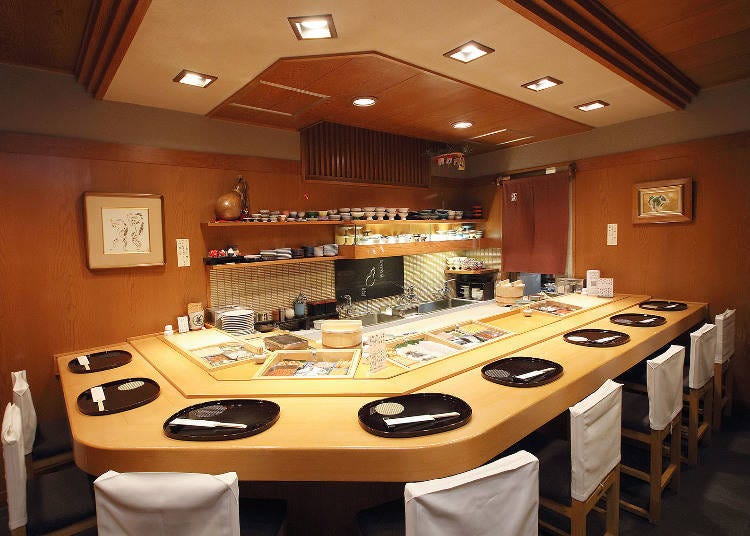
The shop is run by head chef Masatoshi Watanabe, a sushi chef from Aizu, Fukushima Prefecture. After training at sushi restaurants in Aizu and Tokyo, he worked for about 10 years at Sapporo's famous sushi restaurant, Sushizen, before becoming independent. Since then, he has continued to hone his craft in the corner of this northern Susukino entertainment district for the last 40 years.
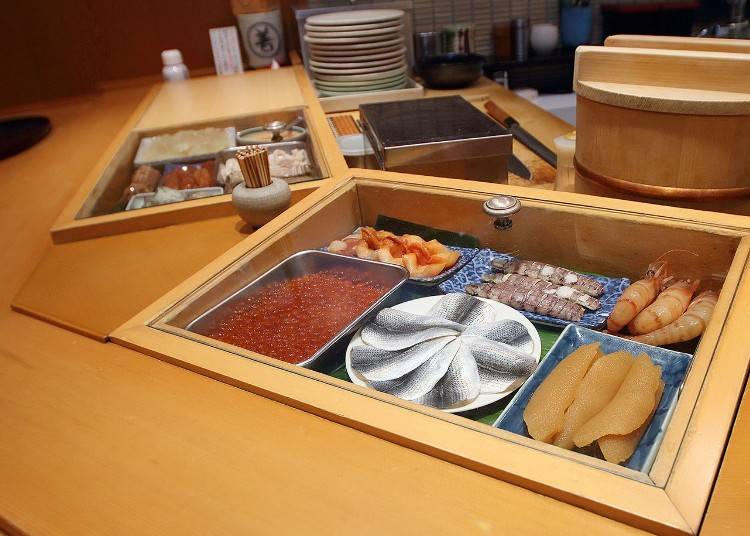
Coming from Aizu, one of the chef's specialties is a local Aizu cuisine called kozuyu. One of Aizu's long-standing customs is to serve a small soup together with alcohol at feasts. This helps prevent sickness from drinking on an empty stomach.
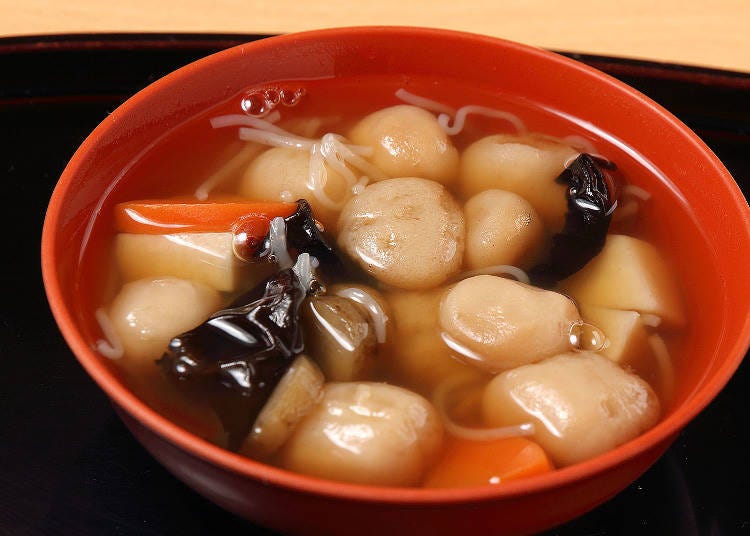
After filling your stomach with a bit of broth, it's time for some authentic Edomae sushi.
The menu starts you off with 4 individual dishes, followed by sashimi, and rounded off with 7 types of sushi. You will be asked your preferences first, so if there are any items on the menu that you do not like, you can swap them for something else. If you are still hungry after the meal, you can order some additional sushi.
This course is about 12,000 yen. Prices for liquor and additional sushi are separate.
Sushi-dokoro's Rare Sushi Dish
Next, we will introduce a dish that is considered a rare gem even in Hokkaido, which is known for its marine products. That dish is called "Ibaragani no Hogushimi no Uchiko-kake" (Shredded Thorn Crab topped with Roe).
Thorn crab is similar to king crab. However in recent years, fishing hauls have decreased sharply in Hokkaido, making it a valuable catch. The crab meat is served together with the egg roe on top.
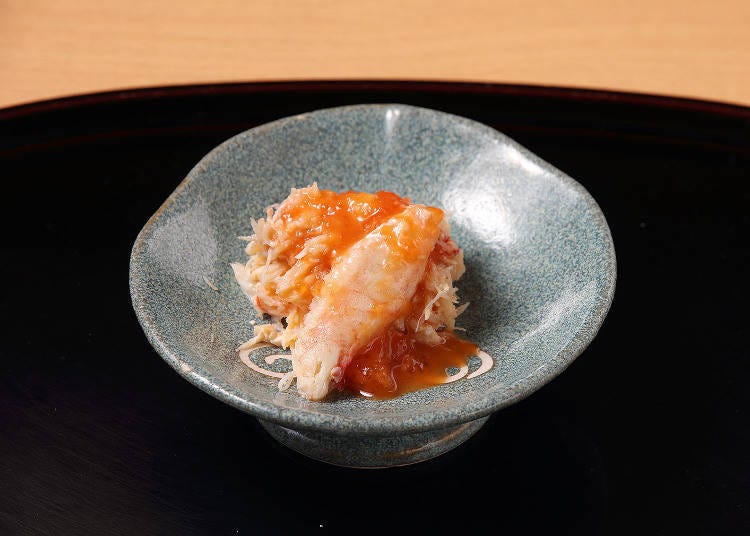
This exquisite crab dish is Crab Miso Tofu Chawan-mushi. In order to keep you from getting too full with just this dish, the only ingredient is the crab miso tofu, sprinkled with crab ankake (a thick sauce) and salmon roe. This dish is defined by its rich and delicious taste!
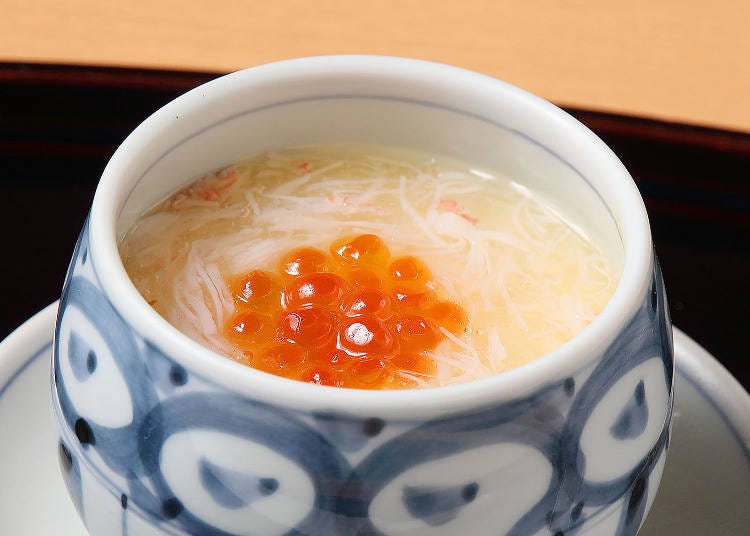
You can also enjoy several other unique sashimi dishes, including aji (raw horse mackerel), carefully boiled to remove the smell and served in a special homemade sauce, as well as sashimi topped with bonito and chopped green onions roasted in wasabi soy sauce.

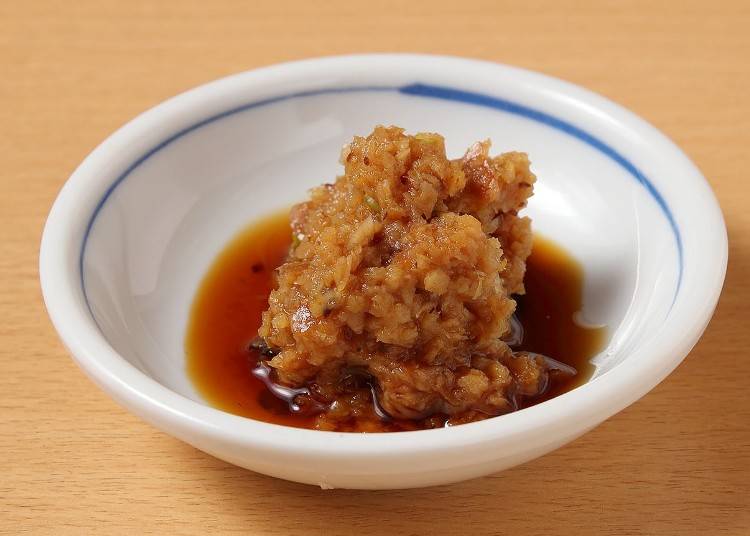
After the smaller dishes comes the sushi we've been waiting for!
There are three pieces: flounder with Gagome kelp from Minamikayabe in Southern Hokkaido, pickled tuna soaked in homemade sauce, and pressed mackerel with kelp. Each piece is mildly salty thanks to the soy sauce, and have a light elasticity. It's a delicious combination that goes perfectly with sake.
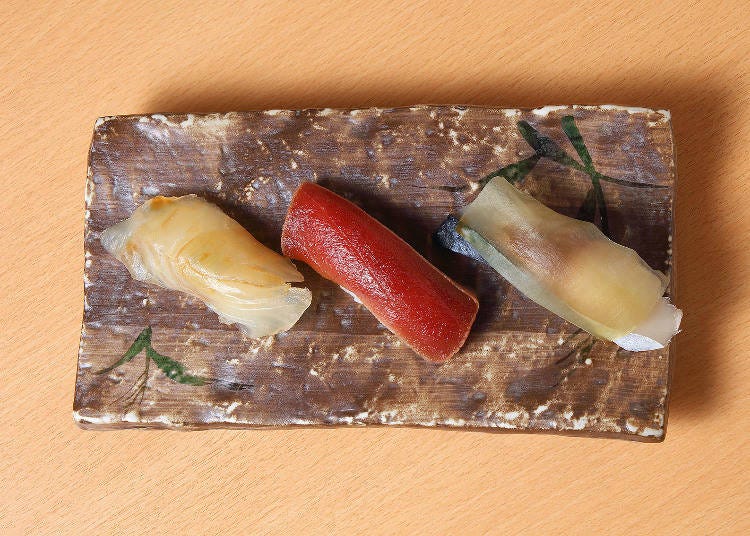
Each delicious piece is served one after another. One of the best dishes, and a personal favorite of the chef himself, is the uni (sea urchin). The sea urchin is purchased directly from the Hokkaido production center, and not through the market. Raw sea urchin has a mellow, natural taste. It is odorless, not bitter, and has no unpleasant aftertaste. Even in Hokkaido, which is famous for its abundance of marine products, raw uni is a delicacy!
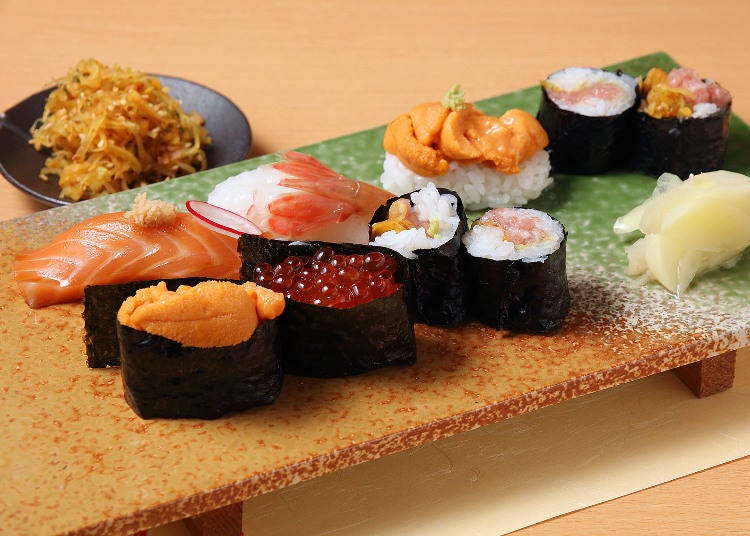
The sea urchin is served as a gunkanmaki roll wrapped in seaweed and lightly sprinkled with soy sauce. You can order a second one without the seaweed wrapping, topped with rock salt and wasabi. The mellow sweetness of the raw Hokkaido uni stands out like a dessert after your meal. Both flavors are so delicious, it's hard to pick a favorite!
You will definitely want to order a second helping of this delicious uni. However, don't overlook one of Sushi-dokoro Hyotan's other popular items - the torotaku!
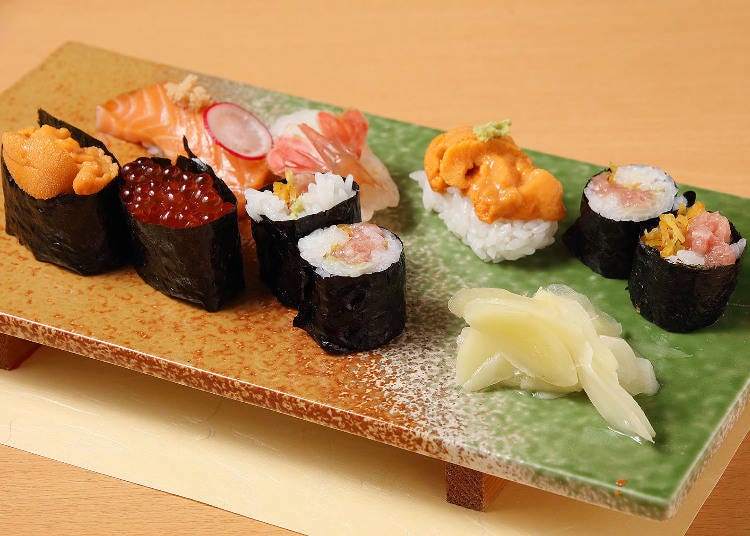
Though Torotaku originated in a sushi shop called Sushizen, Mr. Watanabe, who used to work for Sushizen, was acquainted with its creator. Torotaku was born in the late 1970s through trial and error while trying to create sushi that could compete with Negitoro.
The takuan is more than a simple minced dish. Time and effort are put into seasoning it with sesame seeds and shiso once it's drained. It is also the perfect accompaniment to a glass of sake. Why not order it as a side-dish?
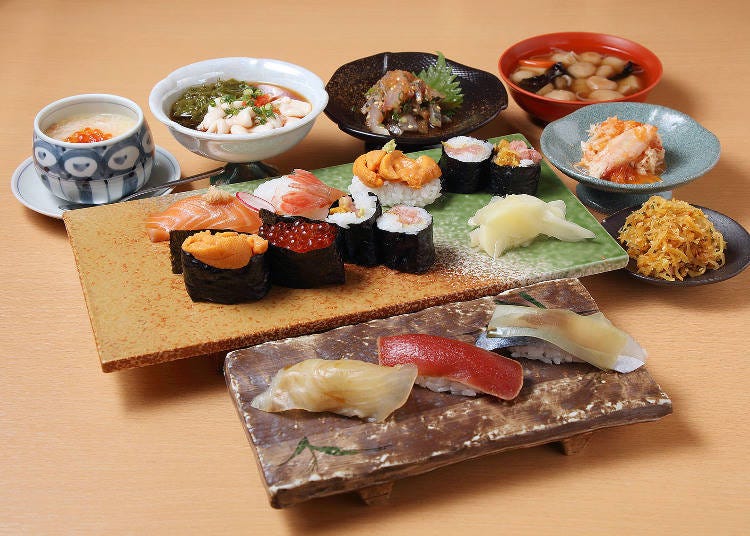
At Sushidokoro Hyotan, you can enjoy the finest sushi and local Aizu cuisine, made with ingredients considered delicacies, even in Hokkaido. There are no foreign language menus available, but that should be no problem if you order the chef's recommended seasonal dish of the day. Because this restaurant has been published in the Michelin Guide Hokkaido 2012 Special Edition, many tourists visit!
Make a reservation, and enjoy an exquisite sushi meal prepared by the friendly sushi chef.
Covid-19 Countermeasures
Sanitizer installed / Disinfected after each guest leaves / Ventilation measures in place / Limited capacity / increased space between seats / Limited admissions, reservation system employed / Entry declined to anyone who is feeling unwell
-
Sushi-dokoro Hyotanすし処 ひょうたん
- Address Gojo DEUX Building 1F, 7-4 Jonishi, Chuo, Sapporo City, Hokkaido
- Phone Number 011-512-8052
Hours: 5:00PM-11:30PM
Hours during recommended business self-quarantine period: 5:00PM-10:00PM
Closed: Sundays and public holidays
6. Sushi Himeshara: Enjoy Sushi Culture at a Famous Two-Star Restaurant in a Residential Area
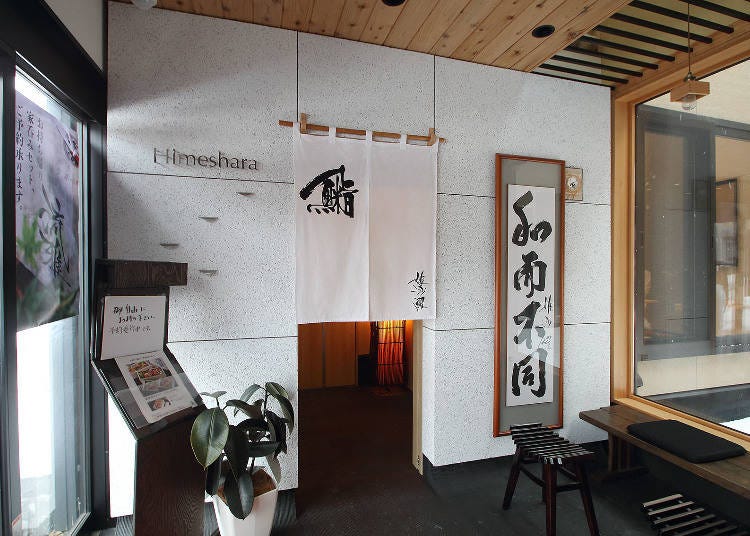
Lastly, we would like to introduce Sushi Himeshara, located about 10 minutes by car or taxi from central Sapporo and Susukino. This well-known restaurant received a two-star rating in the Michelin Guide Hokkaido 2012 Special Edition.
The shop owner, Akira Tanaka, trained at a sushi restaurant in Nagoya, and worked as a Japanese restaurant manager in Sapporo before going independent. After running a shop in Susukino for over 10 years, he moved to his current location in 2017.
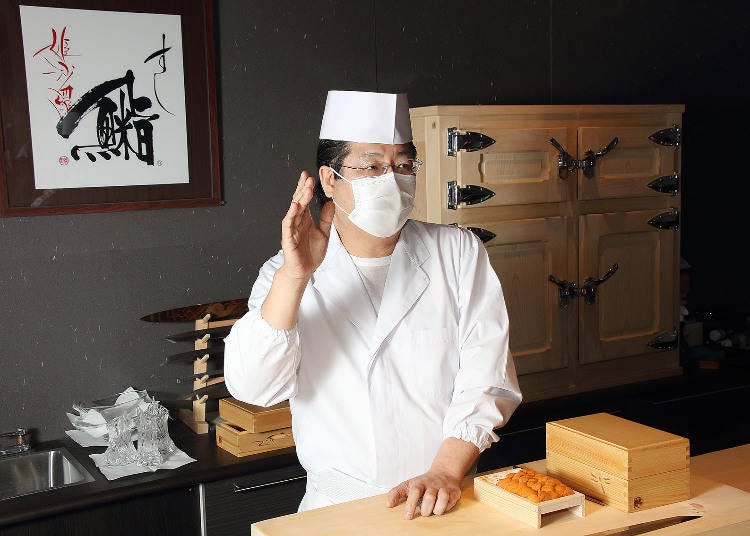
"Sushi and sake are Japanese treasures. There's more to sushi than the ingredients. Cooking skills and creativity, utensils, and vessels are all a part of sushi. And it's not just the fish that makes sushi delicious, but the rice. It is a representative part of Japan's food culture."
Mr. Tanaka shares his commitment. He enjoys traditional Japanese culture. Please note that because of the shop's delicate tastes and aroma, guests wearing strong perfume may be denied entry.
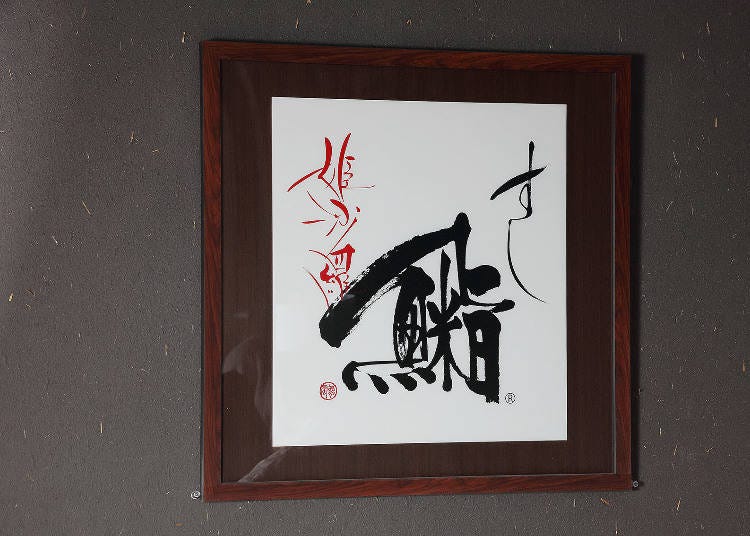
Rice is an important element of Japanese food culture. Sushi rice can be made with white or red vinegar, depending on the other sushi ingredients.
Rather than especially creative dishes and sushi, their focus is on making simple dishes attractive, and making even basic ingredients delicious with minimal effort. How you spend prep time is one of the secrets of sushi culture, and one of the things to enjoy about this restaurant.
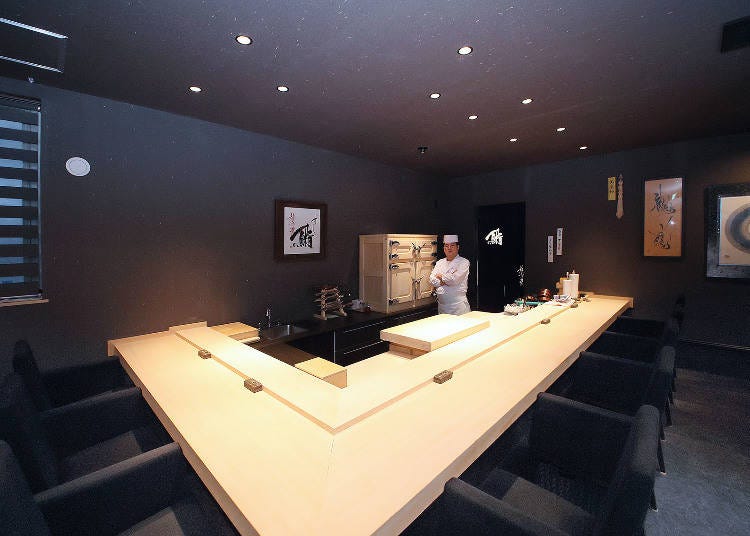
At Sushi Himeshara, it's all about delicious rice.
Their standard dish is the "Sushi and Sake Appetizer Himeshara Course" (25,410 yen, including tax), which includes the most delicious foods of the day, according to the owner. First you are served 4 pieces of sushi, followed by the "Nonbei Set," which includes small seasonal dishes that pair well with sake. The second half of the course continues with sushi.
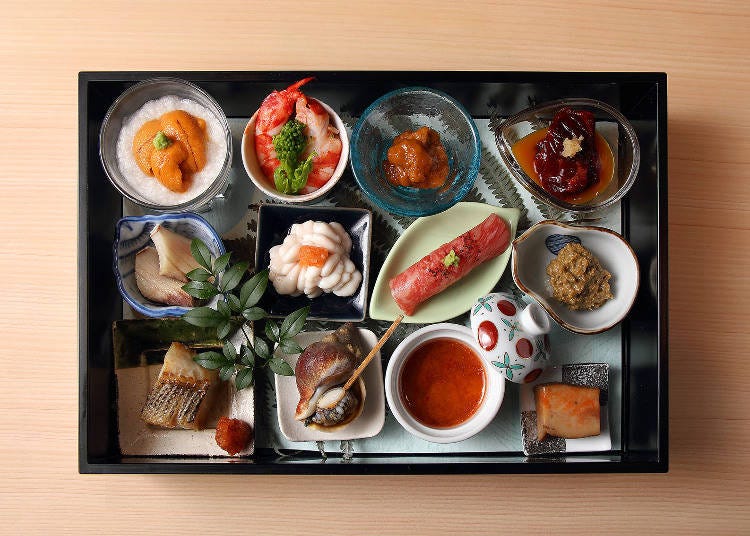
"When you come to a sushi restaurant, you want to eat sushi right away, and fill your stomach before you drink," says Mr. Tanaka.
Exquisite sushi dishes arrive one after another, preparing you for your sake. Not only are they delicious, but their presentation is beautiful, too.
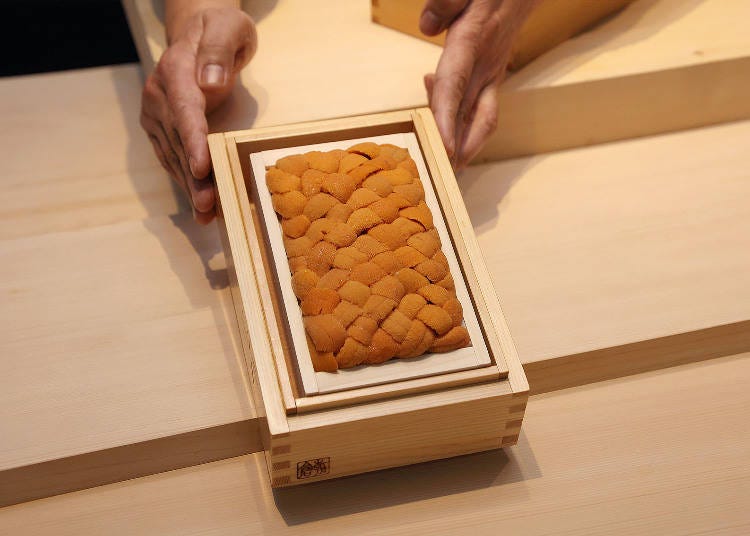
This folded sea urchin is freshly purchased from eastern Hokkaido. If you wait a while before serving it, the flavor becomes noticeably richer.

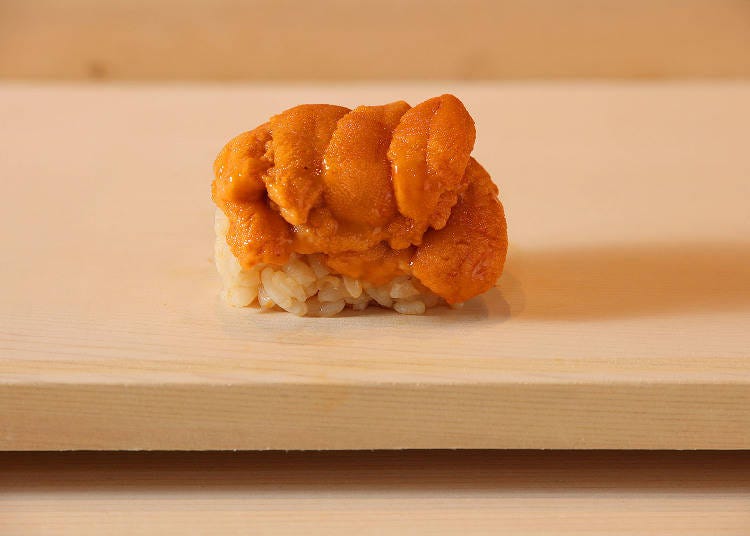
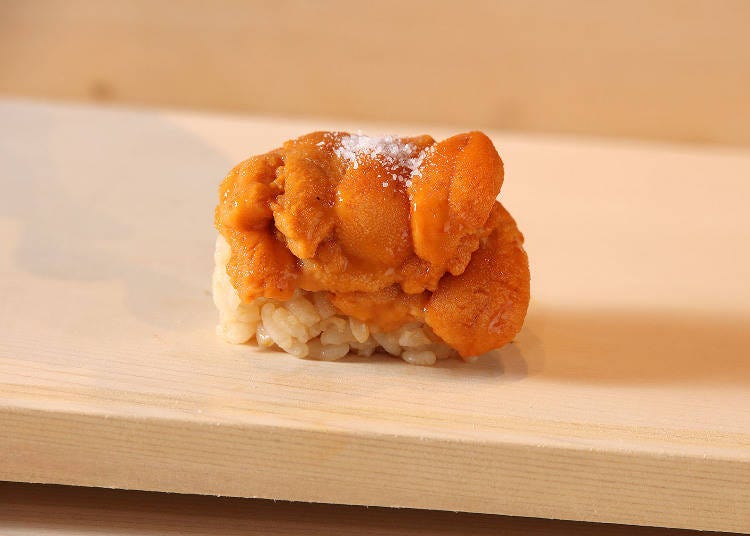
In the style of Edomae sushi, one should eat the sushi as soon as it is served. Open wide and see if you can eat all the uni in a single bite!
The taste of the uni blending with the rice as you chew makes the rice 100 times more delicious. The united is so fluffy you can practically feel it in the back of your nose. This piece alone will have you hooked!
No matter which sushi you choose, each piece is irresistibly delicious, and perfectly complements the rice.
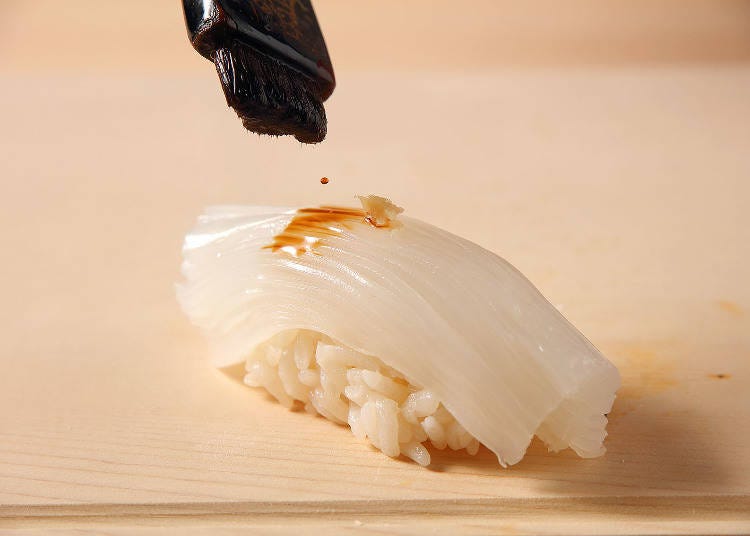
The sweet taste of the finely chopped squid and rice blend deliciously as you enjoy it. Leaving a few grains of rice in your mouth to soak up the lingering flavor is a delicious way to end your meal!
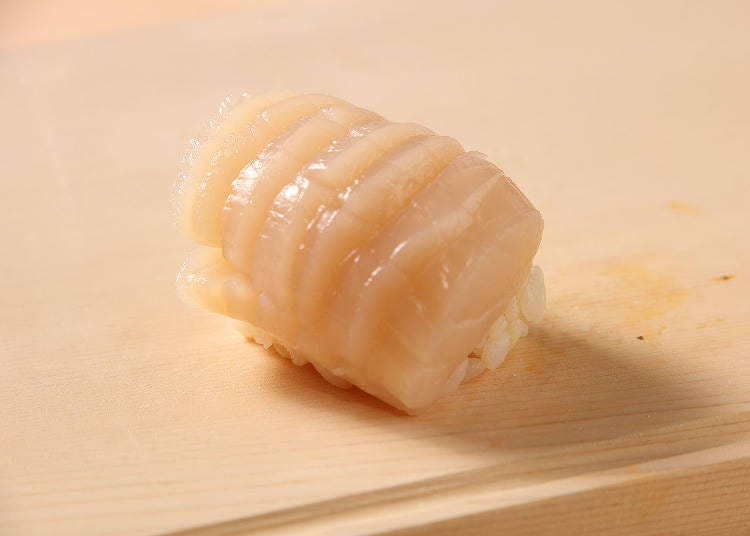
The taste of the scallops mix well with the rice, enhancing the exquisite flavor even more!
The best piece is the botan shrimp hand roll that appears in the latter half of the course. The botan shrimp is wrapped on the top of the rice, with shrimp miso inside and topped with egg.
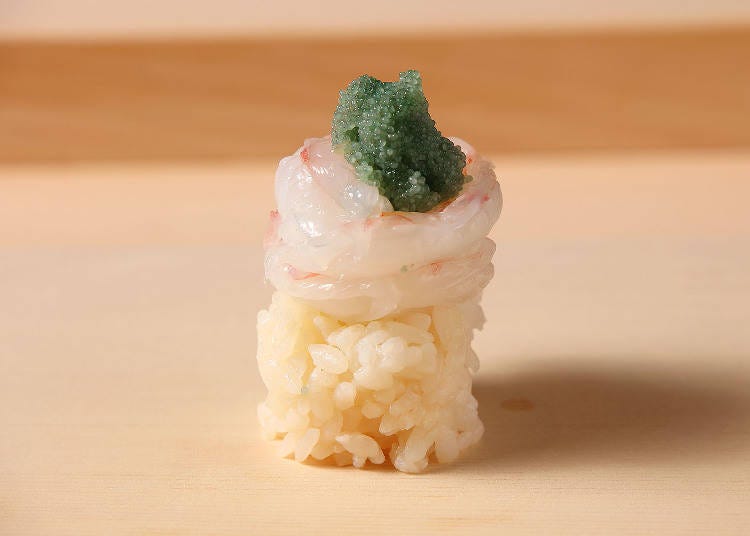
The first thing you'll notice is its crispy texture, followed by the rich flavor of the shrimp miso. It's one of the finest flavors, bound to bring a smile to your face. Some people even visit just to try this shrimp! Why not you?
This famous Sapporo sushi shop does not offer a foreign language menu, however the master will gladly serve you the finest items one after another, so don't worry if you can't speak Japanese! Enjoy the traditional food culture of Japan with the rest of your five senses.
Covid-19 Countermeasures
Sanitizer installed / Disinfected after each guest leaves / Ventilation measures in place / Coin trays used / Staff wear masks, gargle, wash hands regularly, and monitor body temperature / Limited capacity / increased space between seats / Limited admissions, reservation system employed / Entry declined to anyone who is feeling unwell / Masks required / temperature check enforced
-
Sushi Himesharaすし 姫沙羅
- Address 20-1-2 Minami 8 West, Chuo-ku, Sapporo City, Hokkaido
- Phone Number 090-6992-3247
Open for lunch on Saturdays, Sundays, and holidays only (no lunch hours during business self-quarantine period)
Closed: Wednesdays
Today we have introduced 5 specialty shops. Because there are so many sushi shops in Sapporo, it would be impossible to visit them all! But depending on your mood, time, and budget, you can pick the perfect sushi shop for you!
Text by: Nobuka Kawashima
*Information in this article is as of February 2021. Please see official websites for the latest updates.
- Area
- Category
*Prices and options mentioned are subject to change.
*Unless stated otherwise, all prices include tax.
Popular Tours & Activitiess
Recommended places for you
-
Appealing

Shiroi Koibito Park
Theme Parks
Sapporo / Chitose
-

Former Hokkaido Government Office Building (Red Brick Office)
Other Historic Sites
Sapporo / Chitose
-
Appealing

Rukku and Uohei
Izakaya
Sapporo / Chitose
-

Kinyotei
Sushi
Sapporo / Chitose
-
Appealing

Odori Park
Parks
Sapporo / Chitose
-

Nakamura
Sushi
Sapporo / Chitose
-
Ad

Smart Ways to Avoid Crowds and Enjoy a Safe, Comfortable Trip to Noboribetsu Onsen
-

Expert-Recommended: 9 Hakodate Hotels Serving Up the Best Breakfasts in Town
by: Nobuka Kawashima
-

BIGGEST SALE ALERT! SATUDORA Tax-Free Winter Sale: Stack Coupons for Massive Savings!
by: Guest Contributor
-

Great Local Eats: 5 Expert-Recommended Local Chain Restaurants in Hakodate
by: Nobuka Kawashima
-

Scenic Road Trip from Hakodate to Matsumae: Stunning Views, Traditions, and Tasty Delights
by: Nobuka Kawashima
-
Ad

Cycling Through Hokkaido: Discover the Beauty of Memuro and the Tokachi Plains
-

Noboribetsu Onsen: 5 Best Things to Do in Japan's Famous Hot Springs Town!
-

Family-Friendly Dining: 5 Must-Try Seafood Restaurants in Hokkaido
by: Nobuka Kawashima
-

From Luxurious to Quirky: Savor 120 Glorious Minutes of All-you-can-eat Hokkaido Sushi at 'Uoppshu'
-

The Sushi Enthusiast's Guide to Otaru: 5 Curated Restaurants for Uni, Seafood & More
-

Sapporo New Chitose Airport (CTS): Complete Guide to Restaurants, Souvenirs, Shopping & More!
-

Where to Stay in Noboribetsu Onen: 6 Ryokan Hotels in Hokkaido's Spa Wonderland
by: Masakazu Yoshida
- #best sushi hokkaido
- #things to do hokkaido
- #best ramen sapporo
- #what to bring to japan
- #new years in tokyo
- #what to buy in ameyoko
- #japanese nail trends
- #what to do in odaiba
- #onsen tattoo friendly tokyo
- #daiso
- #best sweets otaru
- #japanese fashion culture
- #best nature furano
- #japanese convenience store snacks
- #best japanese soft drinks















